Paris sightseeing plan - map, tickets, attractions, monuments, accommodation, interesting facts
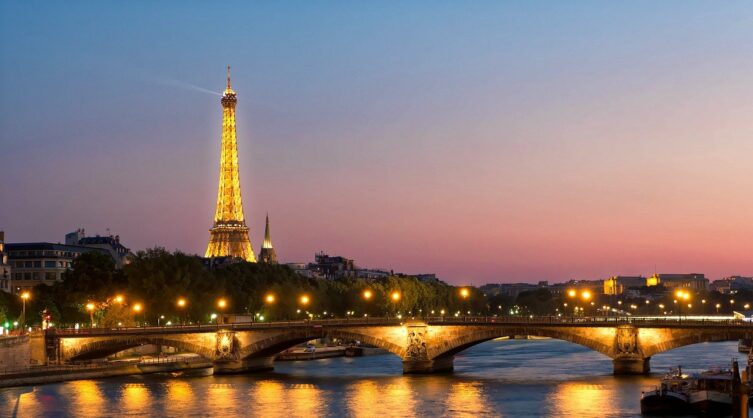
Lutetia
… Or actually this Paris Paris. It was a small settlement that was founded in the XNUMXrd century BC on a muddy islet surrounded by the waters of the Seine. The settlement was founded by a small, Celtic tribe of Paris. The muddy nature of the island was less important to them than the safety guaranteed by the river waters surrounding the island wide.
When the Romans came here in 52 BC, they saw exactly what I just described, that is: an island, a mud and a settlement. The place quickly became known as the "Mud of Paris," which in Latin sounded exactly: Paris Paris.
Over time, the name was naturally shortened, and finally from Lutetia Parisorum only remained Paris.
The island where the history of Paris began is now City Island. Yes! Exactly the one on which today stands the medieval Notre Dame cathedral, the Sainte-Chapelle chapel or the Palace of Justice with the medieval Conciergerie, called during the French Revolution the "guillotine hall".
Then the city began to expand beyond the area of the island, and the first direction of expansion was the shore where it is now located Latin Quarter.
I will finish with a really short, historical introduction, because this post is not about the history of Paris, but about how to organize a visit to see it in the best possible way.
Here we will focus on the practical organization of the trip, which will allow you to create your own sightseeing plan and plan your time as best as possible. The more so as tourist attractions in Paris are often very far from each other, and there are long lines at the entrances at the attractions (they can be avoided, but I will write more about it in a moment).
Appropriate organization of the trip is therefore crucial to ensure that the sightseeing is a pleasure and does not turn into the torment of standing in long queues.
Paris sightseeing itinerary
Preparing a universal plan for visiting Paris is not easy at all, if it is at all possible. I spent many weeks thinking about this post. When I finally wrote the opening sentence, I knew it would be a really well thought out plan. A plan that each of you will be able to bend and adapt to your needs, creating your own unforgettable trip through one of the most visited cities in the world.
I decided to divide the description of visiting Paris into several parts:
- first let's take a look at map of attractions in Parisin order to realize where are the places that interest us the most, what are the distances between them and how the sightseeing route will be.
- then we will try logically divide the route into fragments in such a way that an interesting and convenient plan is created. We will divide the visit into consecutive days, and the days into meaningful stages and attractions.
- at the end I will add a short one descriptions of each of the proposed attractions along with a handful of practical information (GPS coordinates for navigation to help you navigate the city on your own), historical curiosities, etc.
All attractions have their numberwhich is visible in the table of contents i in the headers with descriptions of each attraction and on the maps I have prepared. Brief, bright and clear.
Due to the fact that Paris is the most convenient to travel by metro, I will try to give the name and location of the nearest metro station in the descriptions of attractions.
So you will get a ready-made set of blocks from which you can assemble - at your own discretion - a sightseeing plan adapted to your own needs.
I will also present in detail my own plan proposal, written for a few days, which you may like the most, and will certainly be a good base for your own modifications.
Use GPS coordinates!
For each attraction, I provide precise GPS coordinates that will allow you to always reach your destination. Just go to this page on your phone, click on the link next to the coordinates of the attractions and the navigation application will open automatically.
Simply walk towards your chosen tour point along the streets you wish to walk along. Treat the navigation on the phone rather as information whether you are going in the right direction and approaching your destination, or whether your fantasy is already taking you in the wrong direction 🙂
When you reach one point of the trip and want to go further, you click on the coordinates of the next point and so from point to point you can freely explore Paris on your own, as if you lived here all your life.
Entrance tickets to attractions in Paris - the key to success!
Of course, a well-thought-out itinerary is important, but the admission tickets to attractions are absolutely the most important. Any, even the most perfect plan will fall to pieces when it suddenly turns out that at the Eiffel Tower or before entering the Louvre you have to queue for 3 hours for tickets, and the nearest free seat to enter is in 6 hours.
Constructing each plan you need start by checking the availability of tickets for the day and time that interests you. The assumption that you go blind to some attraction and only look for tickets on the spot is pointless. Nerves, frustration and wasted time are then guaranteed. In Paris, there are almost always queues to the most important attractions. Guaranteed!
Fortunately, for some time now, the sale of tickets to the most crowded attractions is also conducted via the Internet. The ticket is usually bought for a specific date and time. Then you just come in at the indicated time and go in without queuing. Most often, for tourists who have already bought tickets, there is a separate entrance, so that they do not have to squeeze through the waiting queue.
In my opinion, wherever it is possible to purchase tickets via the Internet, you must do so.
Sometimes an additional handling fee is added to the price of an online ticket (these are surcharges in the area, e.g. EUR 2 or 3), but if someone asks me if I prefer to queue for a few hours in the full sun, or maybe it is better to pay extra EUR 2 and enter no queue, the answer seems simple.
Of course, not everywhere such a surcharge is added and many venues sell tickets online at the same price as at the cash desk, but it is worth knowing that this practice is sometimes encountered.
I am not providing a list of attractions in which an additional handling fee is added to online tickets, because these rules sometimes change. By the way, the amount of the surcharge is not large enough to make entry to the attractions dependent on it. I can't imagine anyone going to Paris and giving up the Eiffel Tower due to the EUR 2 surcharge for the internet ticket 🙂
Finishing the topic of tickets, for each attraction (if possible) I will try to provide a link to the page where you can buy admission tickets to it. I assume that such a simplification may be very useful for you.
WARNING!
If the ticket page opens in a language that you find inconvenient, then You can change the language of the website at any time (Polish language is also available!). The language selection is at the top of the page.
Paris Museum Pass - the city card of Paris museums
There is a very interesting proposal in Paris city card entitling to free entry to about 50 museums. Among them are the most interesting, which we intend to enter as part of the sightseeing plan, including: Louvre, Triumphal arch, Museum d'Orsay, Pantheon, Pompidou Center, chapel Sainte-Chapelle, the palace on the island of Cite that is Concierge, Napoleon's tombThe Army Museum Museum in the Orangery (!!!) Picasso Museum and many more in and outside Paris.
It is definitely worth considering buying Paris Museum Pass. The card is sold with a validity period of 2, 4 or 6 days. You can buy it online and pick it up at a point near the Louvre.
I am slowly preparing a detailed description of the kata and there will be a separate entry on this topic. For now, however, I suggest that you read the details, current options and the list of all attractions available for free (as part of the card) directly on the GYG website, also available in Polish, distributing Paris Museum Pass - [click]
Ticket packages – a very interesting alternative!
They are a very interesting option for purchasing tickets ticket packages or alternative city card sets. Let me give you a specific example: Paris and Versailles package – [click]. As I write these words, it costs EUR 57 and includes:
in Paris
– entry to the Louvre for permanent exhibitions
– entry to the Louvre for temporary exhibitions
– admission to the Eugene Delacroix Museum
– cruise on the Seine (1 h 10 min)
in Versailles
– entrance to the Palace of Versailles and all rooms inside the palace
– entry to the gardens and a fountain show accompanied by music
– entry to the Trianon estate
– entry to the coach gallery (on weekends)
– access to an interactive downloadable application
There are also other variants of packages and cards, and over time, new proposals may appear in the offer. So it's worth checking the current offer ticket and city card packages in Paris – [click]
Paris - map of tourist attractions
To get started, take a look at the map below:
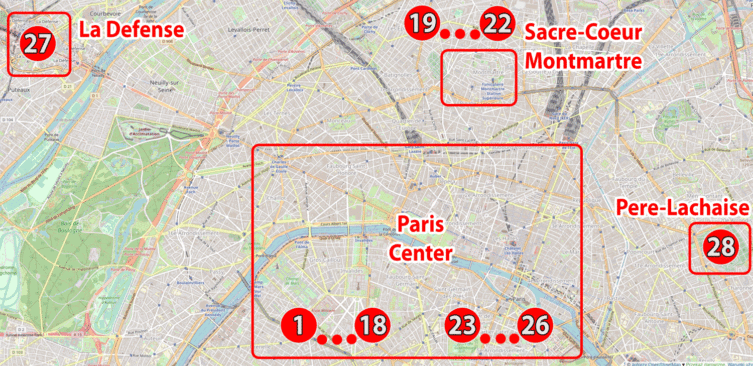
map base: openstreetmap.org
As you can see on the map, I have marked four areas:
- Paris Center
- Sacre-Coeur Cathedral and Montmartre Hill
- the modern district of La Defense
- Pere-Lachaise cemetery
I have separated the marked areas as separate fragments, because they are very distant from each other, and I recommend moving between them by metro. On the other hand, inside each of them (according to my plan), you will rather move around on foot.
Of course, the greatest amount of walking is in the largest area, the "Paris Center". There are plenty of attractions here, and the optimal solution seems to be to divide the visit into two or even three days. You can find such a three-day sightseeing plan prepared by me below, but apart from it for people who do not have that much time, I have also prepared a plan for one (!!!) day.
The one-day plan is very demanding and focuses on attractions that can be seen from the outside. In some places you can go inside for a short time, assuming that you are going to see only the most important things inside (e.g. in the Louvre).
Entrance tickets to each attraction are the key to the implementation of each of the plans. If you manage to buy them in advance via the Internet and they guarantee you entry at the right time, it will all work out.
Tourist attractions in the center of Paris
It's time to start planning your visit a little deeper. So take a look at the next map I have prepared. The map shows the location of the attractions I have described. So far, the sightseeing route proposed by me is not visible on it yet.
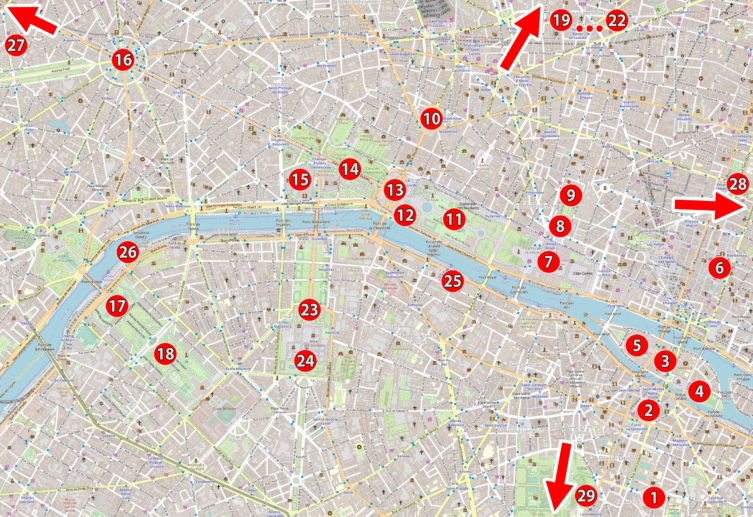
map base: openstreetmap.org
Why did I choose to share the map without route suggestions? I assumed that not everyone would want to visit Paris in accordance with my suggestions. Many readers will want to create their own plan, more suited to their interests and the amount of time they will have in Paris. A clean map, containing only the locations of attractions, is much better suited for independent planning. So I decided to make your life easier.
Attraction map PDF
I know a lot of people like to have a map with them. Therefore, based on the above maps, I have prepared a special map of visiting Venice to download to your phone in PDF format. The map can be enlarged and scaled, and if necessary, you can open wider descriptions with one click (eg to use GPS coordinates).
The map is adapted to the shape of the phone screen 🙂
WARNING!
Red markers with attraction numbers on the PDF map are active! After clicking on the marker, a short description of the selected attraction will open with GPS data and an active navigation link. Clicking on the navigation link will automatically trace the path to the attraction from where you are.
download english .pdf version: Paris – tourist map, guide, sightseeing plan PDF – [click]
Paris sightseeing itinerary
The time has finally come for some concrete proposals. Before you start building your own plan, I suggest you read my suggestions. I think that after analyzing what I have prepared, it will be easier for you to create something of your own. It is very likely that you will use my proposal in full or make only minor modifications.
The basic itinerary for visiting Paris is divided into three days. In addition, it can be extended with proposals for separate trips outside Paris, i.e. visiting Versailles and visiting amusement parks (Disneyland Paris and Park Asterix).
At the end, I have prepared a plan for those who have really little time and would like to see as much as possible, i.e. sightseeing in one day!
Sightseeing of Paris - first day
And again for the beginning the map. It only contains a fragment of what I have already presented before. In the map below, I have limited myself to the area where the walk will take place. This time, I also marked the walking route on the map.
You don't have to follow the exact route I marked. Walking along other streets will be equally attractive.
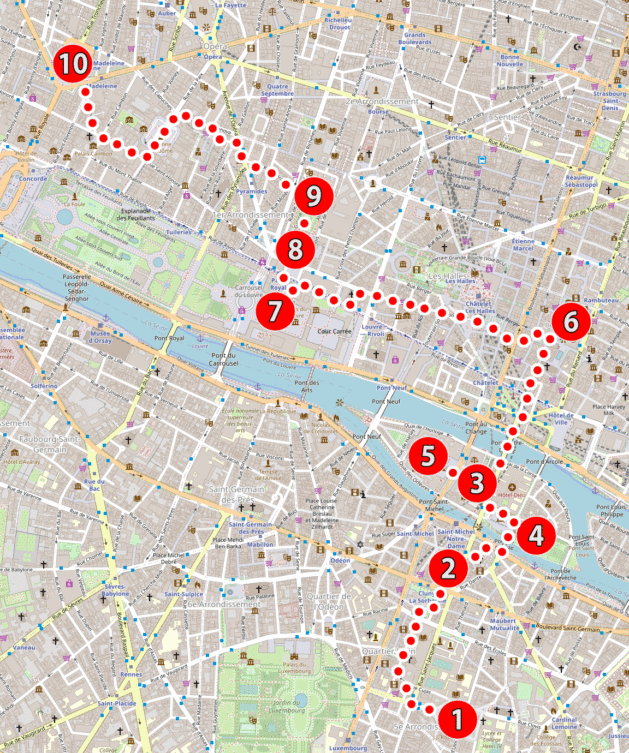
1. Pantheon
2. Latin Quarter
3. Island of Cite (Île de la Cité)
4. Notre Dame Cathedral
5. Sainte-Chapelle Chapel
6. Pompidou Center
7. Louvre (Musée du Louvre)
8. Palais-Royal
9. Gardens by the Palais-Royal
10. Church of St. Magdalene (Église de la Madeleine)
map base: openstreet.org
Going at my discretion, I recommend using the GPS coordinates provided by me. Clicking on them will start navigation on your phone. As you move through the streets of Paris, you don't need to go where the navigation shows. Treat its indications rather as a hint about whether you are approaching your destination point, or perhaps you are already moving away. In practice, this approach to sightseeing gives a lot of freedom and gives a lot of pleasure from exploring the city.
Length of the route: 7 km
Walking time (without visiting attractions): 1 hour 40 minutes
The course of the route: Pantheon - Latin Quarter - Cite Island - Notre Dame - Sainte-Chapelle - Pompidou Center - Louvre - Le Palais Royal - Jardin du Palais-Royal - St. Magdalena
At first glance, the route seems very short. However, take into account that you can spend countless hours in the Louvre itself. Added to this is the Pompidou Center and several other facilities. At the end of the day, it will probably turn out that there was not enough time and you would like more.
You can also open the walking route in the form active Google map - [click]
1. Pantheon
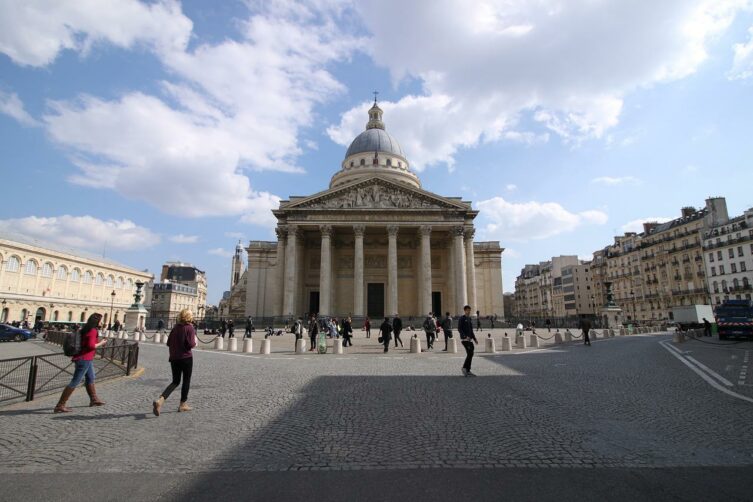
Pantheon is a combination of two Greek words: pan (all) + theos (God). The Pantheon, in short, was therefore by default a temple built in honor of all gods. The one in Paris was modeled after the Pantheon in Rome, but was to serve as an ordinary church. Its destiny changed after the French Revolution. Bonaparte decided that it would be the national mausoleum of France, where the ashes of the most prominent people are placed.
The ashes of Maria Skłodowska-Curie are buried in the Pantheon (and not far from the Pantheon there is her laboratory, where she conducted research - a detailed map on how to get to the Maria Skłodowska-Curie laboratory can be found in the entry about Pantheon - [click]).
In addition to our Nobel Prize winner, you will find here such names as: Wolter, Wiktor Hugo, Jean-Jacques Rousseau, Emil Zola, and Aleksander Dumas.
Check it out: online admission tickets - Pantheon - [click]
Pantheon, GPS coordinates:
48°50’47.2″N 2°20’42.5″E
48.846439, 2.345146 - click and route
Nearest metro stations:
Cardinal Lemoine - line number 10
Place Monge - line number 7
More information about the Pantheon can be found in a separate dedicated post: Pantheon in Paris - [click]
2. Latin Quarter
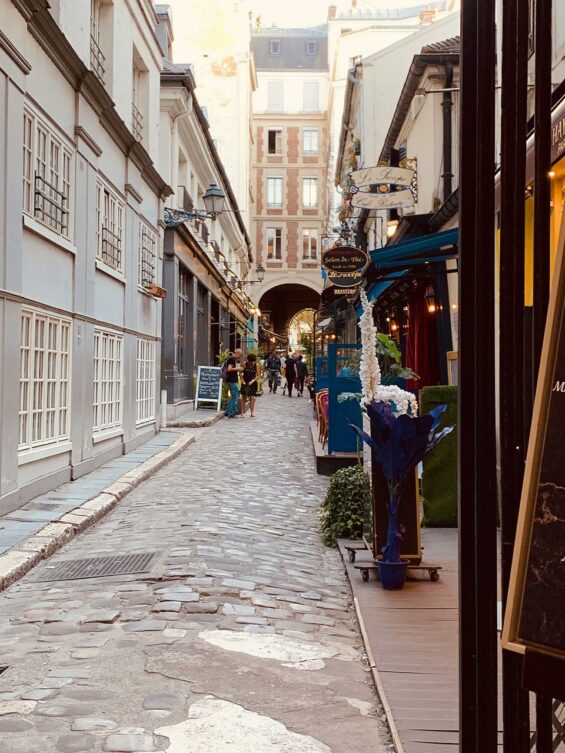
The Latin Quarter covers the area of Paris's two districts (numbered 5 and 6). It was the first direction in which the city began to expand beyond the Cite Island area at the beginning of its history.
In the XNUMXth century, the philosopher Pierre Abelard settled here with his students.
The name of the district comes from the Latin language, which has been widely used in and around the university since the Middle Ages.
Looking at the map, you can say that the district is currently spilling over around the Sorbonne, which is one of the world's most famous universities.
Due to the size of the area, treat the GPS coordinates indicated by me only as an intermediate point. Visiting the Latin Quarter is all about walking the streets that attract you the most and savoring the atmosphere of this part of the city.
Nowadays, the district is known for its typical student atmosphere, cafes and small restaurants where you can waste some time nicely.
Going from the Pantheon in the direction of the coordinates given by me, you will find just such an atmosphere, and by the way, you will see the Sorbonne building on the way.
Latin Quarter, GPS coordinates:
48°51’08.6″N 2°20’43.5″E
48.852389, 2.345411 - click and route
Nearest metro station:
Cluny La Sorbonne - Line 10
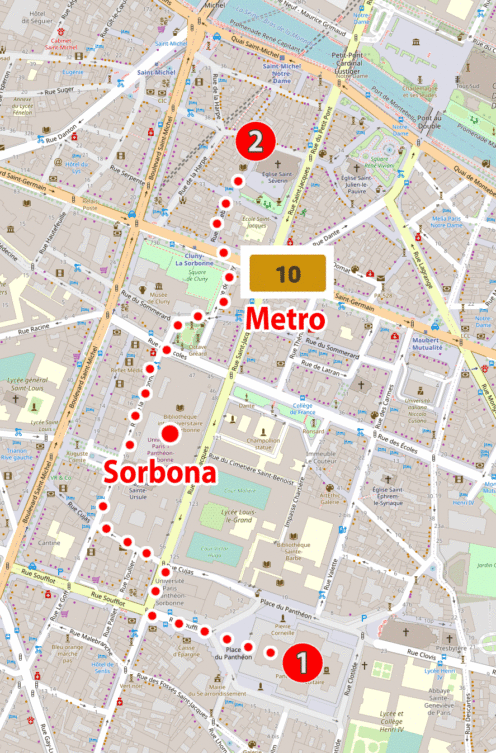
1. Pantheon
2. Latin Quarter
map base: openstreet.org
3. Island of Cite (Île de la Cité)
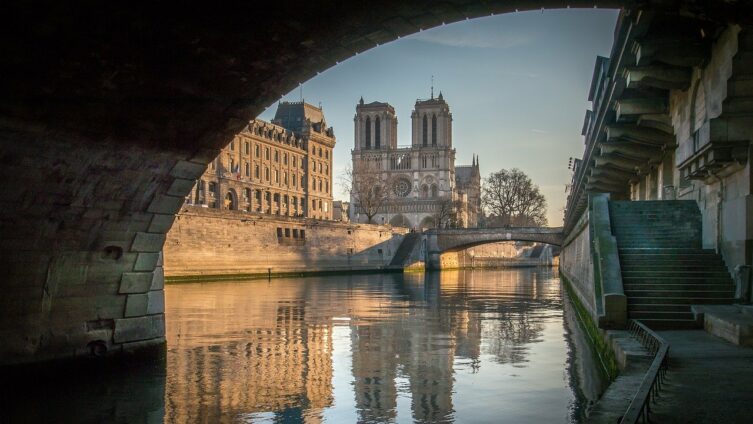
It is safe to say that it is the cradle of Paris. This is where the history of this city began. It used to be very muddy, today it is almost entirely paved and houses some of the most spectacular buildings in the city. You can enjoy the atmosphere of the city's long and turbulent history at every corner.
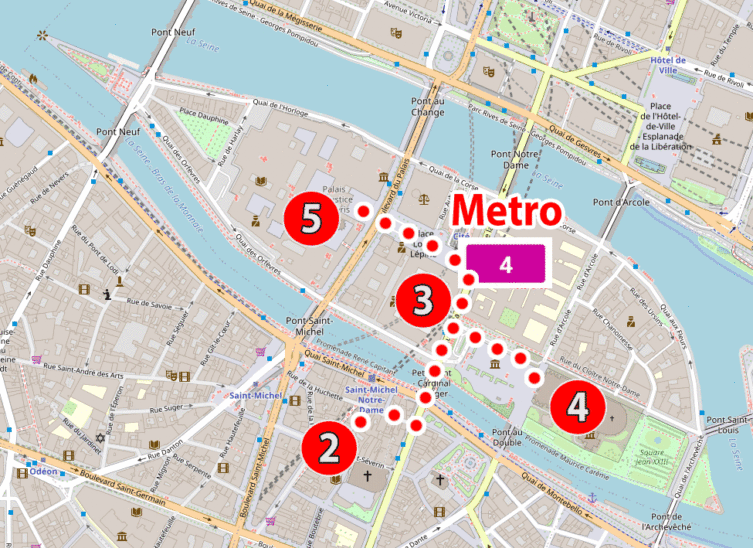
Cite Island, GPS coordinates:
48°51’14.7″N 2°20’50.8″E
48.854071, 2.347447 - click and route
Nearest metro station:
Cite - line number 4
4. Notre Dame Cathedral
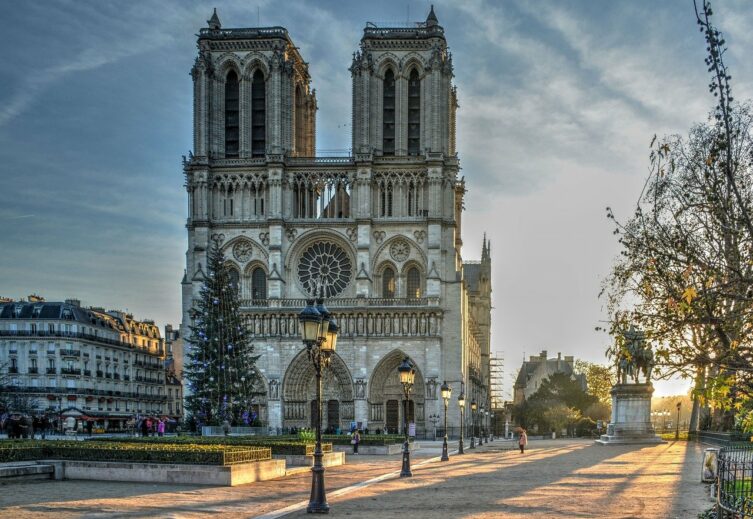
The icon of Paris, i.e. the monumental Notre Dame Cathedral (Our Lady). Unfortunately, it was partially destroyed in a fire on April 15, 2019: the roof, part of the vaults and the cathedral spire collapsed then. It is currently under renovation and is not open to the public, but can still be viewed from the outside and looks great.
It is interesting that to this day it has not been possible to establish who the first architect who designed the cathedral was.
The construction of the cathedral began in the 1163th century (180) and lasted for XNUMX years. In order to build it, it was necessary to demolish two churches built on the previously located pagan temple, and the densely crowded houses surrounding it.
On August 10, 1806, one of the most important relics for Christianity was placed in the cathedral treasury: the crown of thorns of Jesus Christ.
On the day of the fire in 2019, the crown was in the cathedral and there was a real threat of its destruction. On the same day she was transferred from it to another place (probably to Sainte-Chapelle).
I marked the location of the cathedral (4) on the map next to the description of the island of Cite (3).
Notre Dame Cathedral, GPS coordinates:
48°51’11.8″N 2°20’56.5″E
48.853286, 2.349032 - click and route
Nearest metro station:
Cite - line number 4
Curiosity:
It is worth knowing that the cathedral treasury also contains a historically significant memento for Poles. There is a reliquary of the Holy Cross tree, which was part of the Polish Crown Treasury and was present at the coronation of all Polish kings, starting with Władysław Jagiełło ... until he suddenly disappeared from Poland.
So how did the reliquary end up in Notre Dame in Paris? History is prosaic.
In April 1669, King John II Casimir illegally deported him to France (after his abdication).
Four years after his departure, Jan Kazimierz died. After another three years (in January 1676) he was buried in the Wawel Cathedral, but his heart remained in Paris.
The heart of the Polish king is located in a magnificent tomb in the church of Saint-Germain-des-Pres, part of the abbey of the same name (near the Latin Quarter), where our king was an abbot for the last four years of his life.
Church of Saint-Germain-des-Pres, GPS coordinates:
48°51’14.7″N 2°20’01.3″E
48.854077, 2.333702 - click and route
Nearest metro station:
Saint-Germain-des-Pres - Line No.4
5. Sainte-Chapelle Chapel
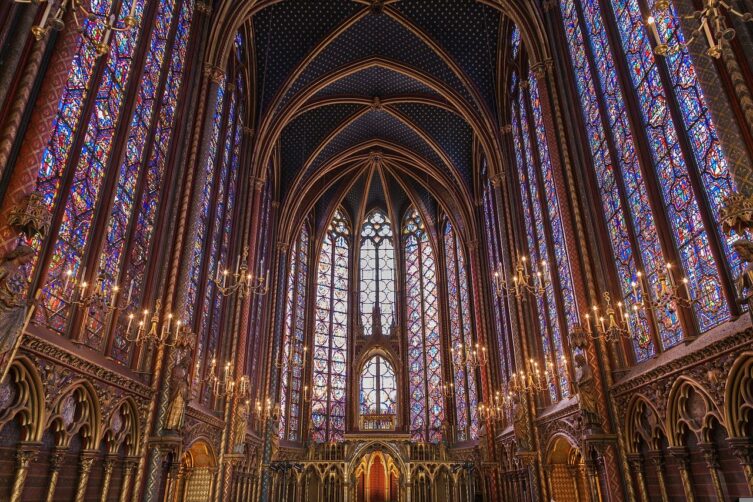
The chapel was built to house one of the most valuable relics of Christianity - the crown of thorns of Christ (upper chapel). Over time, other Christian relics and relics of the patron saints of France (lower chapel) found their place in the chapel.
Really amazing is the upper chapel, the walls of which consist almost entirely of colorful stained glass windows. Real madness!
The photos may show off some of the charm of the upper chapel, but obviously won't replace the live experience. I highly recommend visiting Sainte-Chapelle.
I marked the location of the chapel (5) on the map next to the description of the island of Cite (3).
Check it out: online admission tickets - Sainte-Chapelle - [click]
Sainte-Chapelle Chapel, GPS coordinates:
48°51’19.2″N 2°20’42.7″E
48.855331, 2.345184 - click and route
Nearest metro station:
Cite - line number 4
You will learn more about the chapel in a separate entry: Sainte-Chapelle Chapel in Paris - tickets, sightseeing, interesting facts
6. Pompidou Center
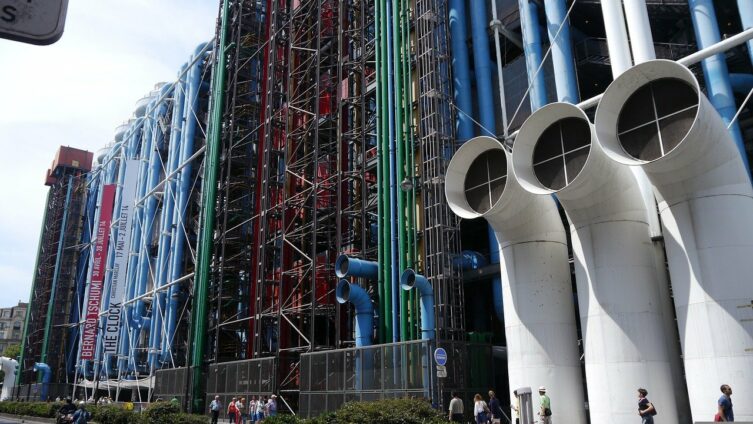
The Pompidou Center houses a museum of contemporary art. However, it is worth coming here even if you are not interested in contemporary art, because the building itself is extremely interesting. If we wanted to present it in a few words, it would have to be said that it is "a structure with guts on top."
Everything that is usually hidden inside the building's volume is outside here: staircases, ventilation ducts and all installations. The effect is that the building from the outside is entwined with a network of colorful installations and structures, while its interior allows for any division of space, creating an ideal entertainment and exhibition space in the intention of the originators.
Each of the installations has a color assigned to it. Looking at the building from the outside, you will see:
- all air conditioning system - blue
- electrical installations - yellow
- safety systems and devices - red
- waterworks - green color
There is a public viewing terrace with a café on the roof of the building.
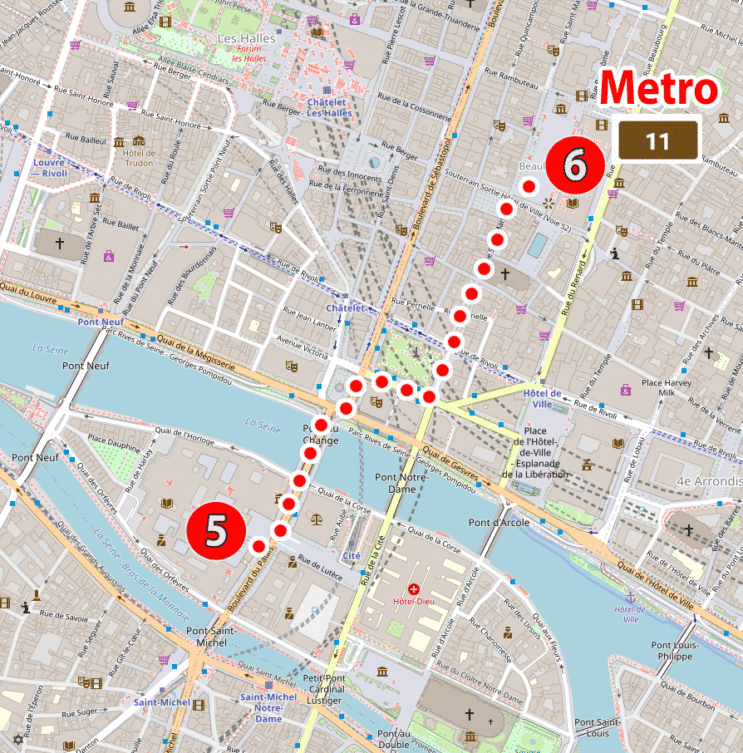
Pompidou Center, GPS coordinates:
48°51’39.1″N 2°21’07.5″E
48.860867, 2.352070 - click and route
Nearest metro stations:
Rambuteau - line No. 11
7. Louvre (Musée du Louvre)
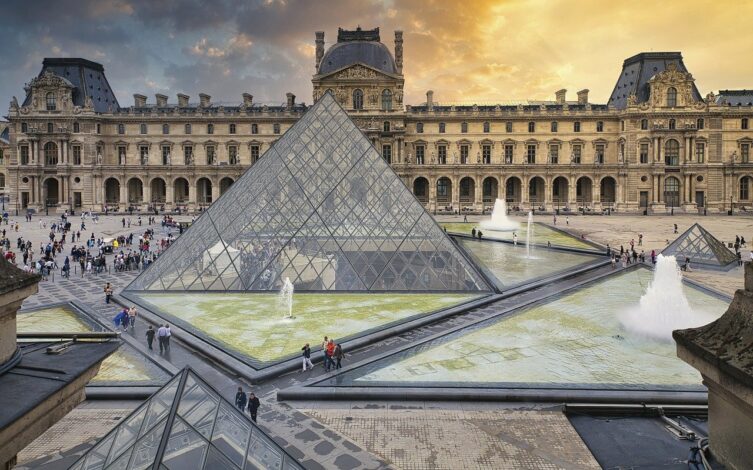
The Louvre needs no introduction. One of the most famous museums in the world with an impressive art collection, it is visited by almost all tourists visiting Paris.
It is therefore worth planning your visit to the Louvre. First, take care of your admission tickets, then think about what you want to see. Currently, tickets to the museum are available only online - [click]. The museum no longer sells at ticket offices.
You can spend two hours in the Louvre, but it could as well be two weeks.
Most people are unable to spend more than a few hours visiting the Louvre, so the museum has prepared a special leaflet presenting only the largest works collected in the museum. In the leaflet you will find thumbnails of the awarded works of art and their exact location on the museum map. You can find the leaflet in paper form at the entrance to the museum, or better yet, download it in advance in electronic form and plan your route: download the leaflet of the Masterpiece of the Louvre – [click]. I downloaded the leaflet provided here from the museum website in September 2022.
It will take you at least two hours to see only what was chosen by the authors of the leaflet in the Louvre.
The main entrance to the museum is through the glass pyramid in the square in front of the museum.
You can also enter the museum directly from the underground station “Palais Royal - Musée du Louvre” below. First you must walk through the Carrousel du Louvre shopping center. The corridor leading to the Louvre is located behind the iconic Inverted Pyramid.
Usually, the entrance "behind the Inverted Pyramid" is much less crowded than in front of the main entrance, so you enter much faster.
Check it out: online admission tickets - Louvre - [click]
The on-line calendar of the current availability of tickets to the Louvre is given below:
In high season, most tourists are not able to buy tickets to the Louvre even online, because they sell out quickly and you really have to watch the moment when the next batches are made available for sale (this happens about two months in advance). However, there is a way to still enter the Louvre, even if you cannot buy a regular admission ticket. What's the way? It's necessary to join an organized group. Such tickets are sold by travel agencies, which buy large pools of admission tickets in advance, and then sell group tours with a guide. The whole thing is a bit more expensive (a ticket to the Louvre in 2023 cost EUR 17, and as a guided service the prices are definitely over EUR 30 and the closer to the date the more expensive). However, if there is no other way out, the decision is up to you: let it go or pay more and enter (I only suggest an emergency solution to the problem).
Below is a link where you can see all currently available group entrance offers in various configurations. There's no guarantee you'll find something you like, but it's always worth checking out.
check out: tickets to enter the Louvre as part of an organized group - [click]
They work similarly Seine cruise operators. They sell their cruises complete with a ticket to the Louvre. If you've planned a Seine cruise and have trouble buying a ticket to the Louvre, you can solve both issues at once by purchasing this combined service. Paradoxically, it is often cheaper to buy a Seine cruise with an entrance ticket to the Louvre than to enter the Louvre in a guided group. This is also worth checking out!
check out: one of the offers of a cruise on the Seine with an entrance ticket to the Louvre – [click]
And at the very end last resort. If nothing I've written so far has helped you get a ticket, you can still check on Tiquets, the other portal providing entrance tickets to the Louvre – [click]
Louvre, GPS coordinates:
48°51’40.1″N 2°20’07.2″E
48.861134, 2.335333 - click and route
Nearest metro station:
Palais Royal - Musée du Louvre - lines 1, 7
8. Palais-Royal
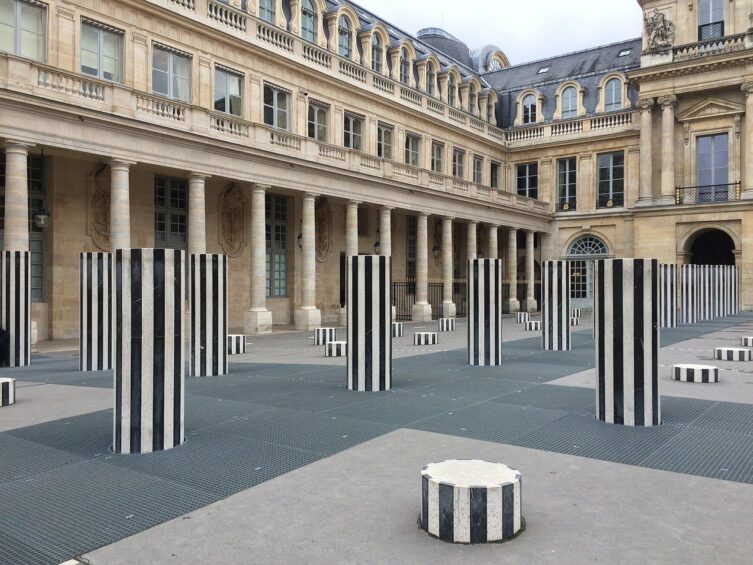
The name of the facility, translated straight ahead as the Royal Palace, is a bit misleading. In practice, the Palais-Royal was the seat of the monarch for only two short periods: during the childhood of Louis XIV and during one year (the first year of reign) of Louis Philippe I.
The Royal Palace, on the other hand, had a different resident who became a part of its history. It was Philip II of Orleans. Called the "dissolute regent" he organized the so-called "Little dinners" that turned into orgies as they lasted.
The very term "small dinners" should be considered ironically ironic as the premise was to deliberately eat and drink excessively during dinner.
… ”We drink and eat until we get sick. Oysters, considered aphrodisiacs, are eaten simultaneously with broth, lobsters, crayfish, crayfish and foie gras. The guests […] swallow mountains of meringue and ice cream ”.
At "small dinners" the food was washed down with champagne, which, as it turned out later, started a real fashion for this drink in France. A large amount of alcohol favored the relaxation of morals. All guests were given matching nicknames over time. During the dinner, Philip II of Orleans called his official (!!!) mistress Marie-Madeleine de Parabère (the wife of Marquis Parabere) as "my tenderloin" or "my leg of lamb". The other guest, Duke de Brancas, bore an even less elaborate nickname. At dinner, Philip II referred to him as "gay Caillette" (caillette is a kind of pork meatball) or "Prince Braquemard" (a braquemard is a medieval knife with a long, wide blade).
The culmination of the evening was an orgy attended by all the guests. During it, the debauched regent vented his sexual needs.
That's what more or less official messages say. However, many historians argue that many of them were deliberately colored and supplemented with completely fabricated stories to discourage some people from the then quite popular Philip II of Orleans.
Currently, the Palais-Royal is the seat of the French Council of State (Conseil d'État), the Constitutional Council and the Ministry of Culture. In one of the wings of the building there is also the French Comedie-Française National Theater.
In the courtyard of the palace there is an art installation created in 1986, the so-called Buren columns. These are symmetrically arranged granite columns of different heights. At the beginning of its existence, the installation was quite controversial, but over time (especially in the time of the fashion for social media such as Instagram or Facebook) it has become almost an icon of Paris and a place where many people want to have a photo.
Entrance to the courtyard is free.
Palais Royal, GPS coordinates:
48°51’49.2″N 2°20’13.6″E
48.863671, 2.337106 - click and route
Nearest metro station:
Palais Royal - Musée du Louvre - lines 1, 7
Curiosity:
Palais-Royal also has a Polish trace. The wedding ceremony of the Polish king Władysław IV with Ludwika Maria Gonzaga took place here (in 1645), at which the groom, Władysław IV, was not present.
The wedding took place in the so-called formula per procura, i.e. without the presence of one of the spouses. Władysław IV was replaced during the wedding ceremony by the voivode of Poznań, Krzysztof Opaliński.
9. Gardens by the Palais-Royal
There is a beautiful garden next to the Royal Palace. Even though it is located in the city center, it is a wonderful oasis of peace. The garden is a great place to sit down and rest for a while after a long walk.
The garden looks most beautiful in spring, when pink trees bloom abundantly in it. In summer, flower beds of colorful flowers make the rest pleasant.
Gardens by the Palais-Royal, GPS coordinates:
48°51’53.5″N 2°20’15.8″E
48.864864, 2.337728 - click and route
Nearest metro station:
Palais Royal - Musée du Louvre - lines 1, 7
10. Church of St. Magdalene (Église de la Madeleine)
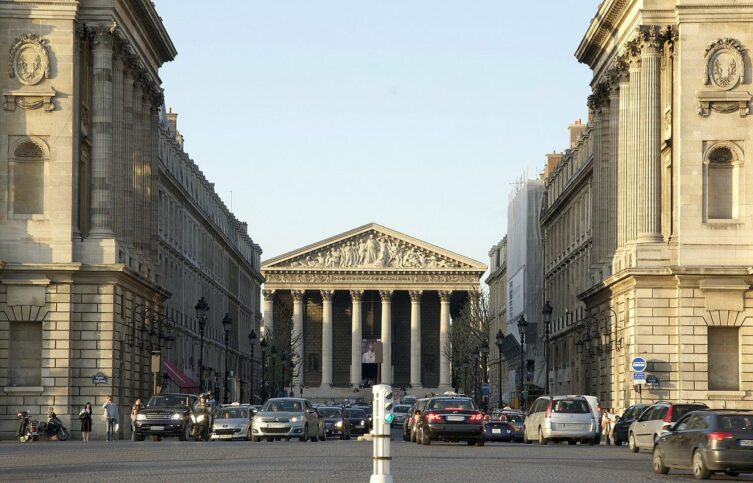
St. Magdalene was built twice and it went through a lot before it turned from a church into ... a church again.
First, it was built on a Latin cross plan. When the main architect died, his successor changed the project and decided to build it on a Greek cross plan. After the French Revolution, Napoleon Bonaparte again decided to change his plans. What had been built so far has been torn down and a new construction has begun: a temple to the glory of the French army.
After Napoleon's fall, the Bourbons returned and the building was to be a mausoleum in honor of the king and queen, who were beheaded by the revolution with a guillotine.
The July Revolution came, and with it a change of king and a change of plans. Ludwik Filip I came up with the idea to convert the building into a railway station, but eventually the plan did not materialize and after a few minor perturbations it was decided that ... it would become a church.
It is worth knowing that in the church of St. Magdalene, funeral masses of two outstanding Poles were held: Frederic Chopin and Adam Mickiewicz.
More information and interesting facts can be found in a separate, dedicated to the church entry: St. Magdalene in Paris - interesting facts, sightseeing - [click]
St. Magdalena, GPS coordinates:
48°52’10.2″N 2°19’26.8″E
48.869501, 2.324100 - click and route
Nearest metro station:
Madeleine - lines 8, 12, 14
Sightseeing of Paris - second day
After the first, very hard day, it's time for the second day - who knows if it's not even more difficult. We will start the second day near the Louvre and end near the Eiffel Tower and the Seine. The place where the route ends is not accidental. I assume that you will get here in the afternoon, and then there will be time (if you have the will and strength) for a cruise on the Seine. After two days of watching Paris and exploring its sights, a glance from the water's position will be a pleasant reminder of most of what you've already seen. I assure you that admiring the monuments when you know what you are looking at is definitely more interesting than a cruise between something that doesn't tell you much. If there is also a sunset (there are special sunset cruises), then a lot of new impressions are guaranteed.
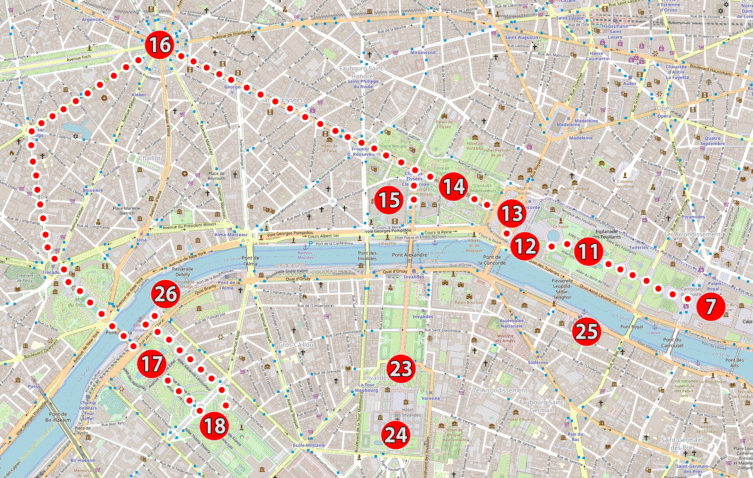
7. Louvre (Musée du Louvre)
(Église de la Madeleine)
11. Tuileries Gardens
12. Museum in the Orangery (Musée de l'Orangerie)
13. Place de la Concorde (Place de la Concorde)
14. Champs Elysees (Avenue des Champs-Élysées)
15. Grand Palace
16. Arc de Triomphe (Arc de triomphe)
17. Eiffel Tower (Tour Eiffel)
18. Fields of Mars (Champ-de-Mars)
26. Seine
Additionally:
23. Palace of the Invalids (Les Invalides)
24. Church of the Invalids and the tomb of Napoleon Bonaparte
25. Musée d'Orsay
Length of the route: 7,5 km
Walking time (without visiting attractions): 2 hours
The course of the route: Louvre - Jardin des Tuileries - Musée de l'Orangerie - Concorde Square - Champs Elysees - Grand Palais - Arc de Triomphe - Eiffel Tower - Champ de Mars - Seine cruise
Again, the route seems very short. Along the way, however, there is the Orangery, the Eiffel Tower, the Arc de Triomphe and finally a cruise on the Seine. You will need to reserve some time for all these attractions and the tour itself will take several hours. So get ready to explore Paris intensively and have lots of great experiences!
You can also open the walking route in the form active Google map - [click]
11. Tuileries Gardens
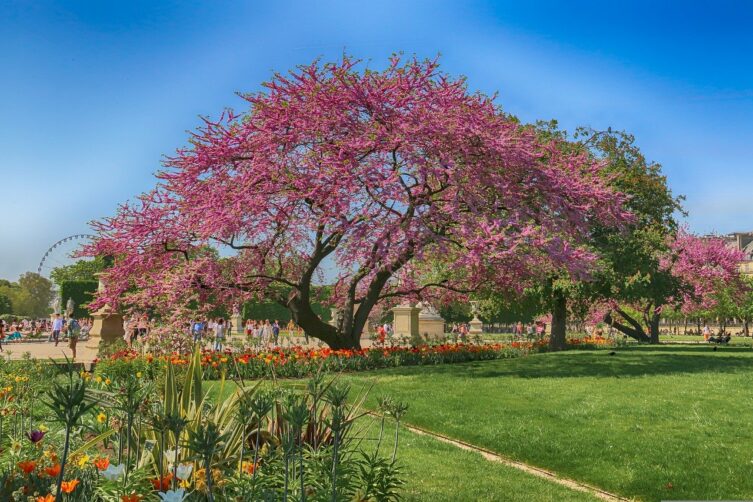
A roofing factory is, to put it simply, a roof tile factory. There used to be a tile factory in the place where the gardens are today. The factory does not exist, and the name has remained, because the roofing factory in French is exactly "tuileries".
The history of this place, however, is not as simple as it might seem: there was a factory that was later demolished and gardens were built. Oh, no no! The story is much more interesting!
In short, let me just say that on the site of the factory, first Queen Catherine de Medici built an impressive palace with a garden, in which (due to superstition) she never lived. They were inhabited by Napoleon Bonaparte, who then exercised his power as emperor.
It is easy to infer from this that the French Revolution did no harm to the palace, but the Paris Commune was not so kind to him. Just then, Parisians burned the palace with their own hands. From May 20, 1871, they began carrying explosives in the form of barrels with gunpowder to the palace and pouring kerosene and turpentine onto the building. In the evening of May 23, the palace was set on fire, and five days later the Paris Commune collapsed.
The idea of rebuilding the palace was quickly created, but there was not enough money and the building was demolished. Today there are only gardens on the site of the palace. Loved by Parisians and eagerly visited by them, they are often a place for picnics, fairs and open-air exhibitions.
Since 2003, the National Committee for the Reconstruction of the Tuileries has been collecting money for the reconstruction of the palace, the cost of which is estimated at EUR 300 million.
Tuileries Gardens, GPS coordinates:
48°51’50.6″N 2°19’39.3″E
48.864048, 2.327570 - click and route
Nearest metro station:
Tuileries - line n ° 1
12. Museum in the Orangery (Musée de l'Orangerie)
The name itself indicates the original purpose of the building. It housed an orangery or a place where orange trees were grown, which in winter were to be protected from the cold, and at the same time had access to light.
Owning an orangery was a symbol of prestige and wealth in the 1852th and XNUMXth centuries. The Orangery in the Tuileries Gardens was commissioned by Emperor Napoleon III in XNUMX.
During its existence, the orangery building was used in various ways, e.g. as a mobilization point or a military depot, but eventually it began to play the role of an exhibition space and, consequently, an art museum.
Today there is an excellent, permanent exhibition of large-format paintings from the series "Water Lilies" by Claude Monet.
Claude Monet donated them to the French state in 1922. Two oval exhibition rooms have been specially designed and constructed for the conservatory canvases. The design of the rooms included the exhibition of exactly the images that we can see in them today. The shape and character of the rooms, their size, the way the light falls and diffuses ... everything has been designed to display Monet's works in a perfect way. Even the natural cycle of the sun and the associated changes in light throughout the day are utilized.
I must admit that the exhibition makes an electrifying impression, and the exhibition of the canvases is actually excellent.
In one of the rooms there are four paintings showing the reflection of the sky in the water surface with lilies on its surface, at different times of the day: from morning to evening.
The second oval room also contains four canvases on which the weeping willow motif was added at the lake shore.
In the middle of the room, there are seating places so that we can sit down and simply enjoy the genius of the painter and the exhibition itself. I sincerely recommend.
In addition to Monet's works, outstanding works by other authors are exhibited in the orangery in the other rooms:
- Renoir: 25 works
- Picasso: 12 works
- Cézanne: 15 works
- Gauguin: 1 work
- Matisse: 10 works
- Modigliani: 5 works
- Laurencin: 6 works
- Rousseau: 9 works
- Sisley: 1 job
- Derain: 30 pac
- Utrillo: 10 works
- Soutine: 22 entries
- Van Dongen: 1 job
The collection is absolutely fabulous!
Check it out: online admission tickets - Museum in the Orangery - [click]
Museum in the Orangery, GPS coordinates:
48°51’50.4″N 2°19’19.2″E
48.863986, 2.321989 - click and route
Nearest metro station:
Concorde - lines 1, 8, 12
13. Place de la Concorde (Place de la Concorde)
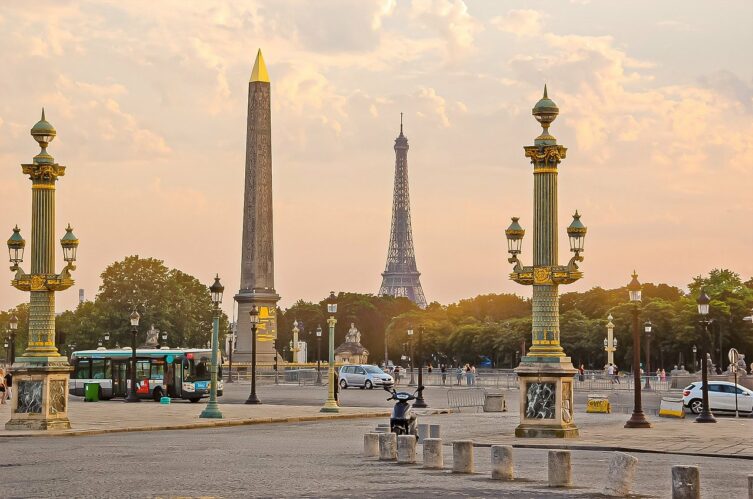
It could as well be called Plac Gilotyny or, more recently, Plac Zgiełku i Noałasu. Why?
The square is now a large, busy, elongated roundabout. There is constant traffic here and a huge tumult. An endless number of cars pass by this way, someone is in a hurry, someone is honking, someone brakes sharply .. Constant rush.
A difficult and not very friendly place to visit, but an important one that should not be overlooked.
The square was built in the second half of the XNUMXth century and originally there was a statue of Louis XV in its center. As you can easily guess, the square was named after this king.
After the outbreak of the French Revolution, the monument was removed, the square was renamed (Revolution Square, of course), and a guillotine was set up at the entrance to the Tuileries Gardens, and over 1300 people were beheaded.
If you look around carefully, you will find eight female statues in the corners of the square. They are personifications of eight of the most important French cities. Under the statue symbolizing Brest, during the French Revolution, King Louis XVI of France and Queen Marie Antoinette were beheaded.
After the French Revolution, the square was given its current name: Plac Zgody, with the hope that the bloody time of terror will never return.
Above the square, there is a huge, Egyptian obelisk placed in the center (similar ones can be found in, among others, the Vatican, Rome, London, New York, Washington, Istanbul and Luxor). The Paris obelisk comes from Luxor, is over 3300 years old, weighs 2300 tons and is 23 meters high. It was donated to France by Muhammad Ali, the viceroy of Egypt, in 1831.
Zgody Square, GPS coordinates:
48°51’55.9″N 2°19’16.3″E
48.865535, 2.321189 - click and route
Nearest metro station:
Concorde - lines 1, 8, 12
14. Champs Elysees (Avenue des Champs-Élysées)
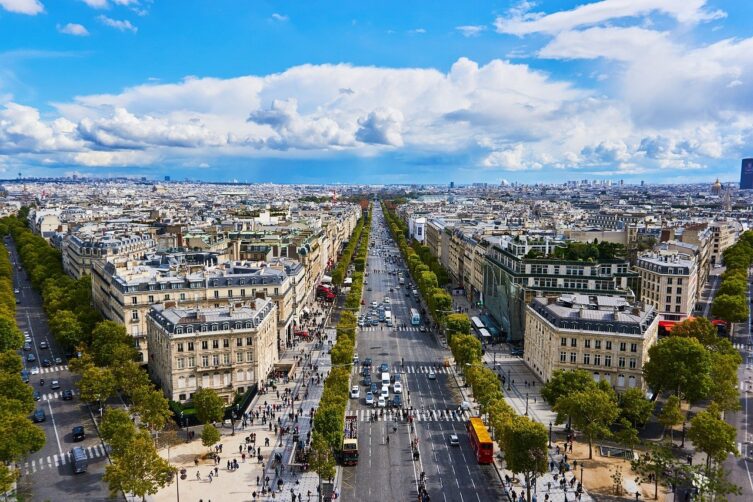
One of the most famous streets and pedestrian streets in Paris. It starts at Plac Zgody and ends at the Arc de Triomphe in Charles De Gaulle Square. There are countless cafes, restaurants, theaters and exclusive shops along the street. At Avenue des Champs-Élysées you can spend any amount of money in no time 🙂
The avenue became a fashionable promenade in the XNUMXth century. The aristocracy eagerly met here, and Queen Marie Antoinette, surrounded by a group of friends, would go out for walks.
It's okay to walk like the Queen of France, right?
Champs-Elysees, GPS coordinates:
48°52’01.0″N 2°19’01.6″E
48.866930, 2.317116 - click and route
Nearest metro station:
Champs-Élysées - Clemenceau - Lines 1, 13
15. Grand Palace
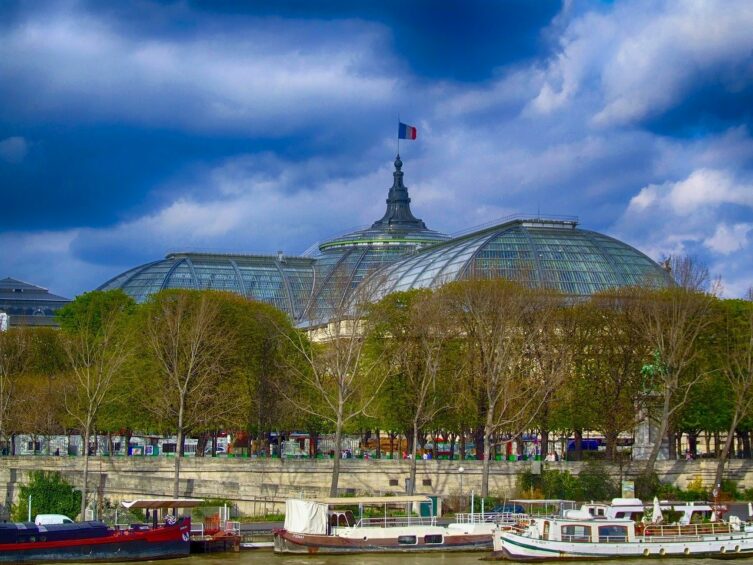
The building was built to host the world exhibition held in Paris in 1900. It is a huge exhibition hall with an impressive glass roof. In recent years, the building has been frequently renovated and therefore it is often unavailable to the public for long periods. It was like that in the years 1993 - 2005 and it is so now. Due to the extensive renovation works required by the facility, it will be closed to the public until spring 2025.
However, it can be viewed from the outside all the time and it is worth doing. It makes a great impression, impressing with its size, panache and daringly designed and made glass roof.
Grand Palais, GPS coordinates:
48°51’58.2″N 2°18’48.2″E
48.866160, 2.313399 - click and route
Nearest metro station:
Champs-Élysées - Clemenceau - Lines 1, 13
16. Arc de Triomphe (Arc de triomphe)
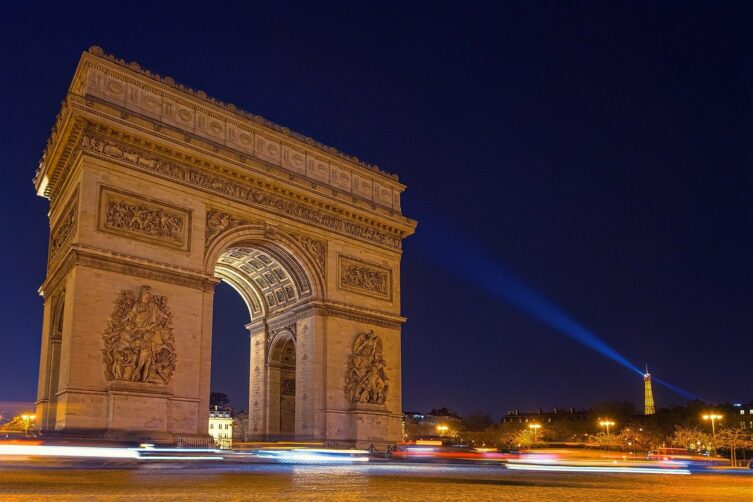
The Parisian Arc de Triomphe is a fairly new construction. It was built in the first half of the XNUMXth century. It commemorates those who died for France during the French Revolution and the Napoleonic Wars.
The construction of the arch was started by Bonaparte, and it was completed by the citizen king Louis Philip I, elected after the July Revolution.
On the pillars and facades of the arch there are reliefs presenting scenes from the most important events and battles from the period of the First French Republic and the First French Empire.
660 names of distinguished persons (mainly generals and marshals) and names of places that witnessed 158 battles were also engraved.
Here you will find the names of seven Poles:
- General Józef Grzegorz Chłopicki (1771-1854) - recorded as KLOPISKY on the western pillar
- gen. Jan Henryk Dąbrowski (1755-1818) - recorded as DOMBROWSKY on the southern pillar
- gen. Karol Otto Kniaziewicz (1762-1842) - entered as KNIAZIEWICZ on the eastern pillar
- gen. Józef Feliks Łazowski (1759-1812) - entered as LASOWSKI on the southern pillar
- march. prince Józef Antoni Poniatowski (1763-1813) - recorded as PONIATOWSKY on the eastern pillar
- brig. Józef Sułkowski (1773-1798) - recorded as SULKOSKY on the southern pillar.
- General Józef Zajączek (1752-1826) - entered as ZAYONSCHECK on the southern pillar
and the names of five places:
- Gdańsk (siege, March - May 1807) - recorded as DANTZIG on the eastern pillar
- Ostrołęka (battle, February 16, 1807) - recorded as OSTROLENKA on the eastern pillar
- Pułtusk (battle, December 26, 1806) - recorded as PULTUSK on the eastern pillar
- Lidzbark Warmiński (battle, June 10, 1807) - recorded as HEILSBERG on the eastern pillar.
- Wrocław (conquest of the city, December 29, 1806) - recorded as BRESLAW on the northern pillar.
Check it out: online admission tickets - Arc de Triomphe - [click]
Triumphal arch, GPS coordinates:
48°52’25.4″N 2°17’43.2″E
48.873734, 2.295325 - click and route
Nearest metro station:
George V - line number 1
17. Eiffel Tower (Tour Eiffel)
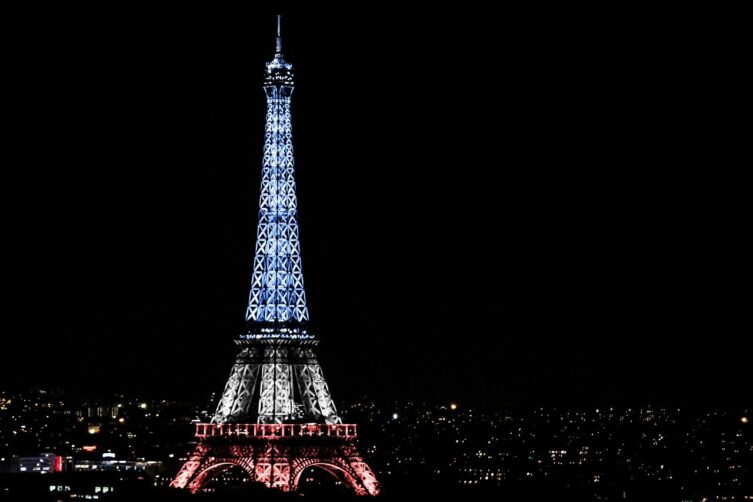
The most important thing about the Eiffel Tower is ... to have an admission ticket. Take care of its history and curiosities second!
The undisputed symbol of Paris, and often even the whole of France, is the most crowded attraction in the city. In high season, it is practically impossible to get to the highest viewpoint if you do not have a ticket purchased in advance. You can forget! Therefore, if you want to visit the tower and go to the viewpoint at its top, first take care of your tickets by purchasing them online. Most tickets are purchased well in advance by travel agencies and tour operators. Only a part of the entire seat package is available for direct purchase for individual customers.
In my experience, the easiest way to buy a ticket with reasonable advance notice is through websites that specialize in the distribution of tickets to tourist attractions. Similarly to tourist offices, they buy large packages of tickets in advance and distribute them further, organizing people into groups of about 20 people. Most often, after purchasing a ticket, you have to go to a specific point near the Eiffel Tower, where the whole group meets and at a specified time, as an organized group enters the tower through a separate entrance for groups, without waiting in line.
When looking for tickets, first check the two pages below (if there are no vacancies on them ... well, that's a problem and you have to keep trying).
- entry ticket to the Eiffel Tower GYG - [click]
- entrance ticket to the tower via Tiquets - [click]
The later you search for tickets and the closer you are to the time of visiting the tower, the higher the admission price. When browsing the ticket offers, pay special attention to whether the ticket includes an elevator ride to the top of the tower (TOP). Some of the offers propose access to the summit as an option that requires an additional payment. The tower has three viewing platforms. A trip to the top is a trip to the third platform (third floor).
You can see the calendar of current ticket availability and the possibility of ordering them online here:
Eiffel Tower, GPS coordinates:
48°51’30.1″N 2°17’40.0″E
48.858348, 2.294439 - click and route
Eiffel Tower, nearest metro station:
Bir-Hakeim - line number 6
Ecole Militaire - Line No.8
Trocadero - lines 6, 9
18. Fields of Mars (Champ-de-Mars)
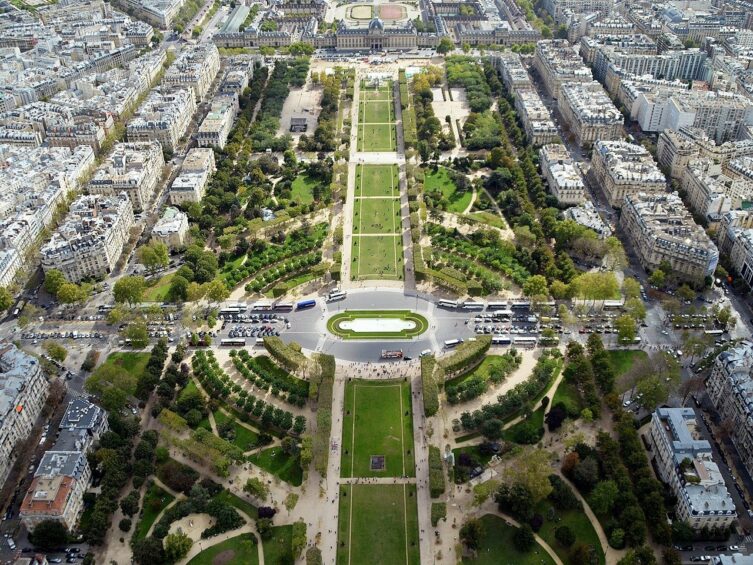
After a long and exhausting day, it's time to rest. The Fields of Mars are perfect for this. Today it is a vast and very pleasant park, but their purpose was different. Military exercises were held in the Fields of Mars (as in Rome). It is not surprising then that on one of their ends (the one opposite to the Eiffel Tower) there is a building of a military school.
In the Fields of Mars there were often significant events that required a sufficiently large space. They were celebrated, among others, the capture of the bastille and balloon flight tests were carried out. It was also the location of world exhibitions that were the direct cause of the construction of the Eiffel Tower. The whole world participating in the exhibitions was to admire the tower erected especially for this occasion.
Fields of Mars, GPS coordinates:
48°51’20.4″N 2°17’54.9″E
48.855657, 2.298580 - click and route
Pola Marsowe, the nearest metro station:
Ecole Militaire - Line No.8
26. Seine cruises
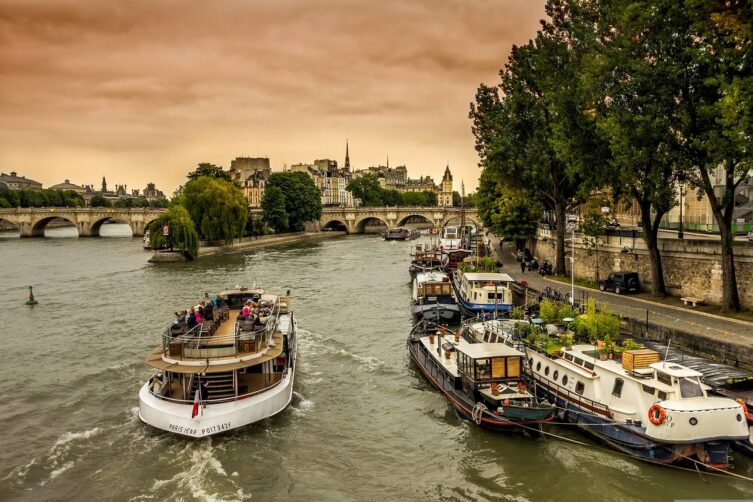
If you still have the strength, I have one more excursion point for you to do that day: a cruise on the Seine.
If you ask yourself the question "is it worth it?", I will answer that it is worth it. The city looks great from the water position. The tour is neither strenuous nor very long and only requires you to sit and admire. An ideal option as at the end of a busy day (or two days, in fact). A perfect summary of everything that has been seen so far, and an opportunity to feast your eyes on it all.
I offer a choice of two types of cruises, depending on the willingness, possibilities and time of day in which the cruise will take place:
- Seine River: daily cruise - [click]
- Seine: evening cruise - [click]
Cruises depart from various departure points along the Seine. I chose the offer with a starting point close to the Eiffel Tower because it fits my itinerary best. If you have a different sightseeing plan, by clicking on the links above you can search for other cruises, starting from other places, that will better fit your plan.
Cruise on the Seine - starting point of the cruise to the Eiffel Tower, GPS coordinates:
48°51’41.7″N 2°17’46.3″E
48.861580, 2.296205 - click and route
River Seine cruise, nearest metro stations:
Bir-Hakeim - line number 6
Ecole Militaire - Line No.8
Trocadero - lines 6, 9
Sightseeing of Paris - third day
For the first two days, we visited most of the most important attractions of Paris centered around the Seine. I devoted the third day to visiting equally important places, but mostly a bit distant from the city center. Their location on the map of Paris can be seen on one of the first maps I have posted, so I will not repeat it.
We will start with the Montmartre hill and the Pigalle district, which you can reach from Montmartre on foot. I have prepared a separate map for this part of the walk.
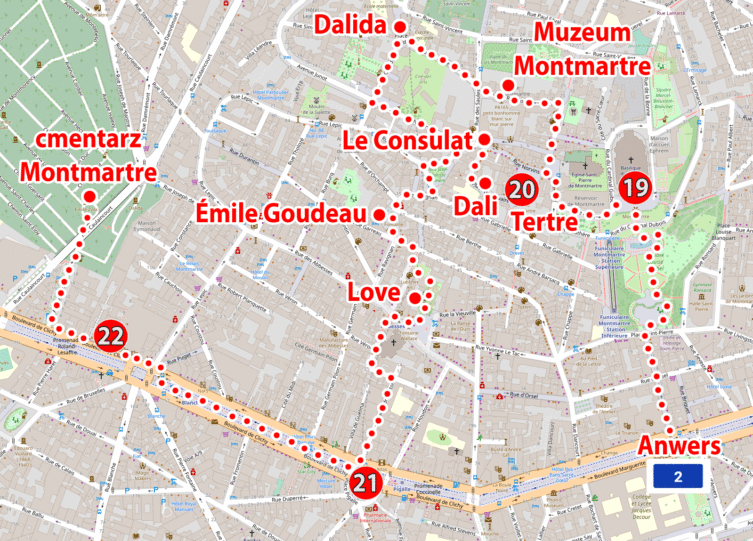
19. Basilica of Sacre-Coeur
20. Montmartre
21. Pigalla
22.Moulin Rouge
The next steps will depend only on you. You probably won't have time to see all the things proposed for this day, although I do not rule out that if you have a long summer day at your disposal, you will be able to get everywhere. However, I recommend visiting attractions one by one. Set the ones that interest you the most at the beginning, and postpone the ones that you can opt out of.
Length of the route - only for the parts on Montmartre and Pigalle: 3,6 km
Walking time (without visiting attractions): 1 hour
Montmartre-Pigalle route: Sacre-Coeur Basilica - Montmartre - Pigalle - Moulin Rouge
Additional attractions that later need to be reached by metro:
- Palace of the Invalids- Museum d'Orsay
- La Defense
- Pere-Lachaise cemetery
You can also open the Montmartre-Pigalle walking route in form active Google map - [click]
19. Basilica of Sacre-Coeur
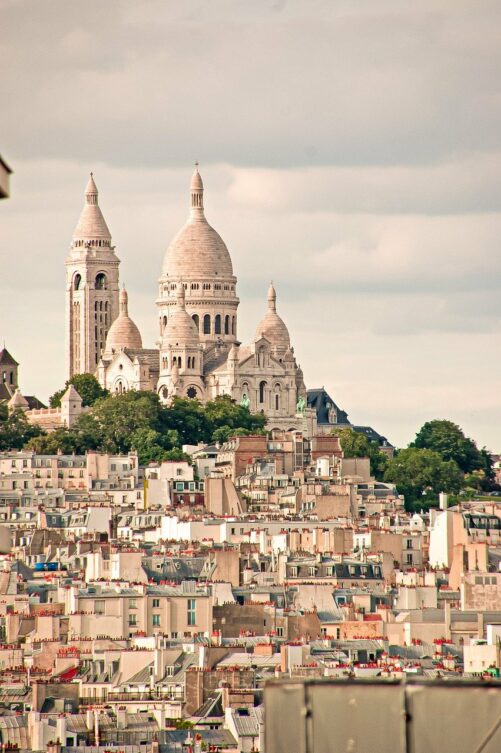
The Sacre-Coeur Basilica can be seen from almost anywhere in Paris. A beautiful, snow-white building towers over the city and attracts attention. It owes its color to the travertine covering its walls, which when exposed to weather conditions is subject to processes that make it take on a white color.
From the terrace in front of the cathedral, or even better from the cathedral dome, you can enjoy the most beautiful panoramic views of Paris. This is where the most beautiful panoramic photos of the French capital are made. However, the entrance to the dome is payable.
Sacre-Coeur Basilica, GPS coordinates:
48°53’10.5″N 2°20’35.2″E
48.886240, 2.343106 - click and route
Sacre-Coeur Basilica, nearest metro station:
Anvers - line No.2
More information about the Sacre-Coeur Basilica can be found in a separate entry: Sacre-Coeur Basilica in Paris - [click]
20. Montmartre
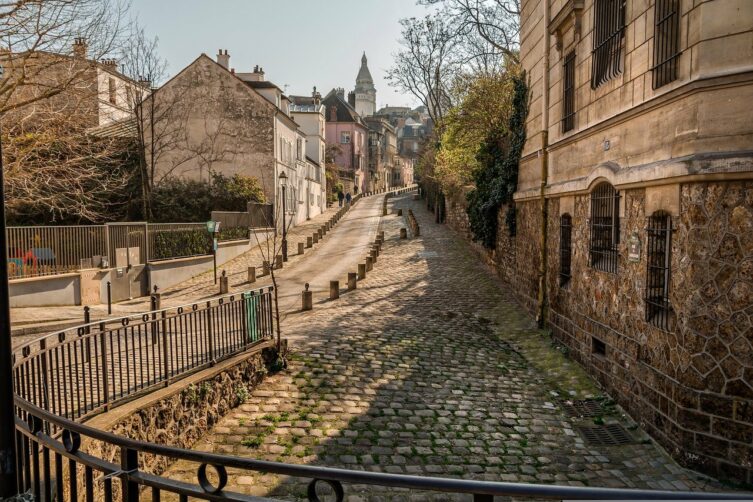
The Montmartre hill, and in fact the Montmartre district, did not become part of Paris until the end of the XNUMXth century. Previously, as an area located outside the strict city, Montmartre grew at its own pace and its own style, slowly building a specific, suburban character, preserved to this day.
In the mid-nineteenth century, or about fifty years before Montmartre joined Paris, artists appeared here, and with them a slightly more relaxed lifestyle. Montmartre became an artistic center, attracting the greatest artistic names like a magnet. The following people lived and worked here: Fryderyk Chopin, Hector Berlioz, Vincent van Gogh, Pablo Picasso, Edgar Degas, Auguste Renoir, Henri de Toulouse-Lautrec.
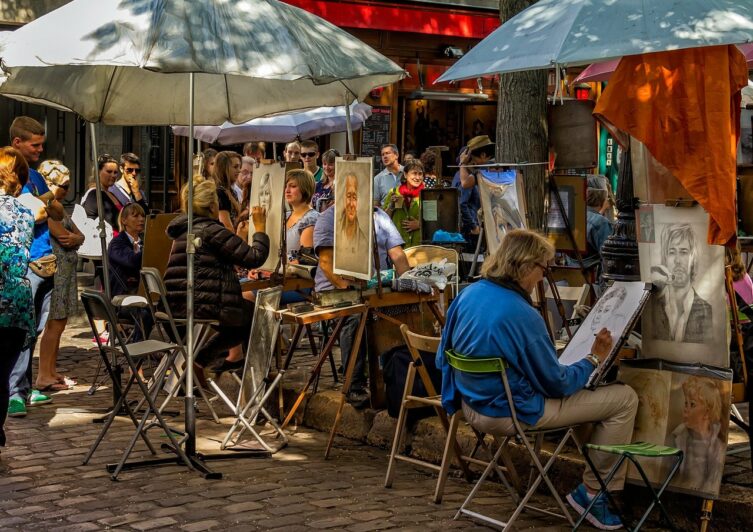
Visiting Montmartre (a detailed map can be found in the entry: Montmartre - sightseeing) starts at the Sacre Coeur cathedral (GPS coordinates of all points listed in the description can be found directly under the description). From here, it is worth going to the nearby square Mound (twenty). In the square you will meet painters sitting behind the easel. Some people kill their free time by painting what they want (then they put up their works for sale), but most of them usually have clients whom they paint portraits "live". You can choose from a variety of styles and techniques. It can be an ordinary portrait or a caricature. Family or solo portrait, charcoal, pencil, crayons, pastels ... All portraits have one thing in common: it is not cheap. For curiosity, it is worth asking about the price. Who knows? Maybe there is a weaker day and there will be a promotion?
Then the trail I suggest leads along typical streets nearby Montmartre Museum (worth visiting), to the square where he has his monument Dalida (the famous singer also lived in Montmartre). Then we head back towards Tertre Square, passing the restaurant on the way "Le Consulat”Which they often visited in the XNUMXth century Picasso, Sisley, Van Gogh, Toulouse Lautrec, Many and many other artists. A few steps from the restaurant there is another interesting one museumpresenting works Salvatore Dali.
If you follow the path I have suggested, you will find the paved Emile Goudeau square, next to it studio had Pablo Picasso. Another point of the walk is Wall of Lovewith the words "I love you" in over 200 languages around the world. An extremely popular place and willingly visited.
Next we go to the Pigalle district, to be precise Pigalle square (21) and to the next point for the Moulin Rouge cabaret.
If you still have the strength and willingness, you can still visit Montmartre cemeterywhich was the first burial site Juliusz Słowacki (the tomb still exists). Currently, among others, Dalida, Edgar Degas, Alexandre Dumas, Emile Zola, Hector Berlioz are buried here.
Tertre Square on the hill of Montmartre, GPS coordinates:
48°53’11.8″N 2°20’27.1″E
48.886609, 2.340850 - click and route
Montmartre Museum, GPS coordinates:
48°53’15.7″N 2°20’26.4″E
48.887699, 2.340671 - click and route
Dalida - a monument and a tiny square, GPS coordinates:
48°53’18.7″N 2°20’17.1″E
48.888534, 2.338094 - click and route
Restaurant "Le Consulat", GPS coordinates:
48°53’13.4″N 2°20’23.2″E
48.887066, 2.339766 - click and route
Salvador Dali Museum, GPS coordinates:
48°53’11.1″N 2°20’23.5″E
48.886419, 2.339858 - click and route
Emile Goudeau square, GPS coordinates:
48°53’09.5″N 2°20’16.5″E
48.885969, 2.337926 - click and route
Wall of Love, GPS coordinates:
48°53’05.3″N 2°20’18.8″E
48.884810, 2.338559 - click and route
Montmartre, nearest metro station:
Abbesses - Line No.12
More information and a map of Montmmartre can be found in a separate entry: Montmartre and Pigalle in Paris - [click]
21. Pigalla
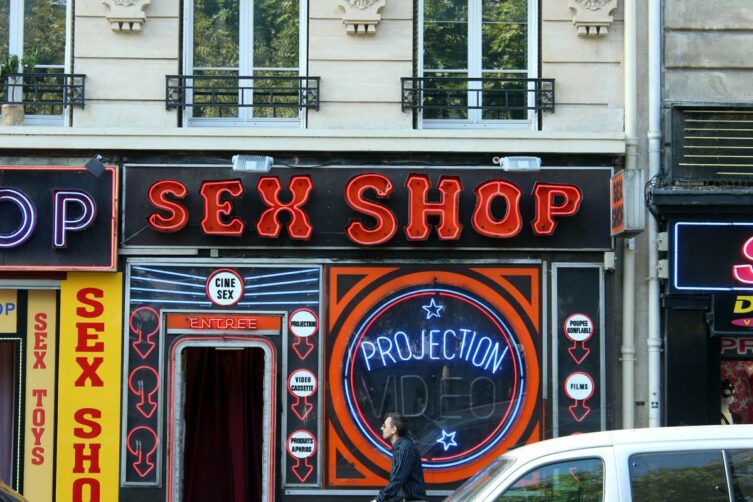
photo: Elisa Michelet
The real publicity of the Pigalle district began to gain attention only at the end of the XNUMXth century, when it became a place where artists associated with Montmartre began to spend their free time. Free manners meant that not only restaurants and cafes were created, but also places where it was possible to meet the bodily needs. One after another, brothels, funhouses and cinemas for adults were opening up. Some venues tried to satisfy more sophisticated artistic tastes, so performances containing erotic elements became popular. Burlesque and dance arts with topless dancers flourished.
Eventually, Pigalle soon became one of the most famous red light districts in Europe, with the central point of Pigalle Square.
Today, Pigalle's character is somewhat less conspicuous, although there is still a high concentration of erotic-related entertainment and commerce. Today these are mainly erotic shops, sex shops, peep shows, dance theaters with erotic elements and, to a lesser extent, rooms by the hour and brothels.
The erotic industry becomes more visible after dark, when neon lights, screaming with vivid colors, advertising various services take over the leading role in the street landscape.
Is Pigalle safe? During the day, definitely yes! In the evening, too, although you should rather not walk the streets alone, because the very impression of changing the face of the streets can make you feel uncomfortable.
Is it easy to fall victim to fraud here? Of course yes! Currently, frauds mainly consist of extorting money in the form of inflated bills. You may find that you will be offered a drink that may cost much more than you expect. Or a stranger (of course substituted by the premises), whom you bought one drink, chose something outrageously expensive. There are many ways.
So if, in addition to a walk along the street illuminated by neon signs in Pigalle, you intend to drink something in the evening, it will probably cost you a lot.
Place Pigalle, GPS coordinates:
48°52’56.7″N 2°20’14.7″E
48.882415, 2.337405 - click and route
Place Pigalle, nearest metro station:
Pigalle - lines 2, 12
22.Moulin Rouge
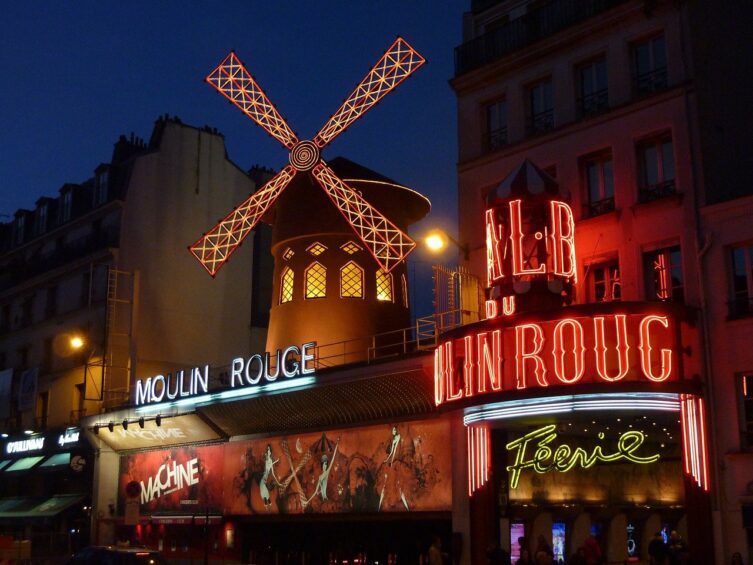
Many wonder why the Red Windmill has become a symbol of one of the most famous cabarets and musical theaters in Paris? The answer is simple. Because when it was built, there were still windmills nearby. The city began to expand dynamically, drawing more and more distant districts into its reach, and the windmill remained as a symbol of what once existed in this place.
Today, the red windmill in the middle of the city, protruding above the roof of the building, is known everywhere and any marketer will say that it would be rather difficult to find a more visible symbol.
From the very beginning, Moulin Rouge presented dance performances, where the dancers were dressed in multicolored, elaborate and eye-catching costumes.
The dancers are often topless in the performances, their bodies are abundantly adorned with jewelry and impressive colored feathers.
It was in the Moulin Rouge that the most famous cancan performances were created and are still on display here today. Performances are usually held twice a day, and tickets are sold well in advance, although they are not cheap.
Check it out: entrance tickets to the Moulin Rouge - [click]
Moulin Rouge, GPS coordinates:
48°53’02.7″N 2°19’56.3″E
48.884075, 2.332303 - click and route
Moulin Rouge, nearest metro station:
Blanche - Lines No.2
23. Palace of the Invalids (Les Invalides)
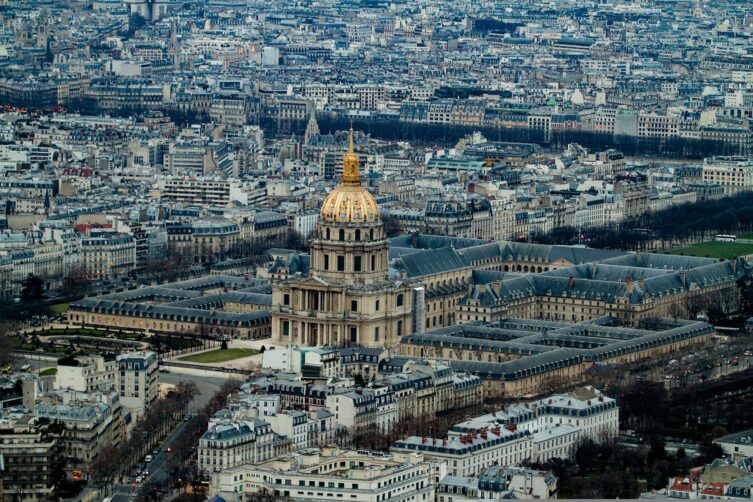
The huge complex of buildings called the Palace of the Invalids was commissioned by Louis IV in just five years. It was built as a hospital and a home for war veterans. The building has a huge courtyard intended for military parades. With time, it turned out that the veterans did not live by parades alone and there was a need to build a chapel. Shortly after completing the construction of the chapel for veterans, the king decided to build a separate, private royal chapel: Eglise du Dome (currently called Dome des Invalides).
Currently, the Palace of the Invalids partially serves as a museum. It includes:
- Army Museum (Musee de l'Armee) - Medieval Hall, Louis XIII Hall, Armaments Gallery, Hunting Hall, Oriental Exhibitions, Handlebars Hall and European Hall (mainly military works of the most prominent European metallurgists), weapons, vehicles and other exhibits regarding I and World War II
- Museum of the Order of Liberation (Musée de l'Ordre de la Liberation) - connected with the period of General de Gaulle's activity.
- Museum of 28D Military Maps (Musee des Plans-Reliefs) - a collection of impressive XNUMXD military maps of real objects. Currently, the museum exhibits XNUMX three-dimensional spatial models presenting fortifications along the English Channel, the shores of the Atlantic, Mediterranean and the Pyrenees.
The ashes of famous figures from French history are buried in the buildings associated with the Square of the Invalids and in its basement (the list of people is available here - [click]).
Check it out: entry tickets to the Army Museum - [click]
Palace of the Invalids, GPS coordinates:
48°51’26.5″N 2°18’46.2″E
48.857368, 2.312823 - click and route
Pałac Inwalidów, the nearest metro stations:
La Tour-Maubourg - line 8
Varenne - line No.13
24. Church of the Invalids and the tomb of Napoleon Bonaparte
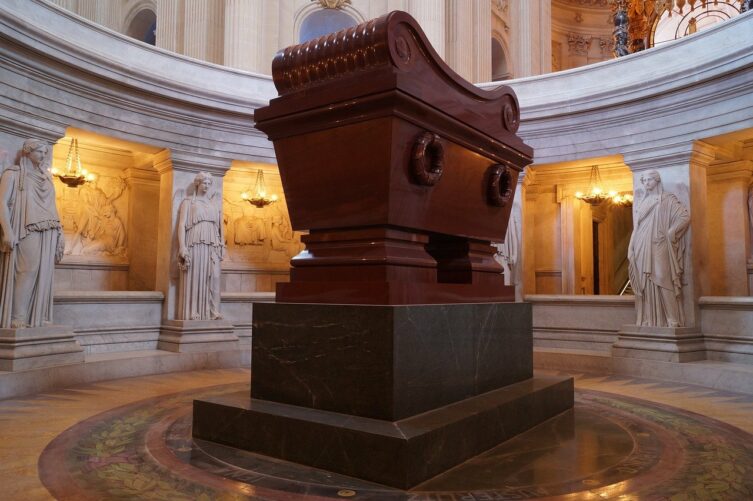
The Church of the Invalids was added to the Palace of the Invalids at the request of King Louis XIV, who wanted to have a private royal chapel in this place. The architecture of the church is inspired by the Basilica of St. Peter in Rome.
Ultimately (according to the king's intention) it was to be the resting place of the royal family. Unfortunately, after his death, the plans changed and the ashes of Napoleon Bonaparte were finally deposited in the Church of the Invalids on the order of King Louis Philippe. Brought from the island of St. Helen in 1840, were embalmed and locked in six coffins:
- the first (inner): tin
- second: mahogany
- the third and the fourth: lead
- fifth: ebony
- sixth (outer): Finnish red porphyry (a type of igneous rock).
Of course, the church with the sacophagus of Bonaparte can be visited. This is done as part of the Army Museum entrance ticket (no separate tickets available).
The facilities are open daily from 10:00 to 18:00. Tickets are EUR 14 (September 2022) and the museum recommends purchasing them online.
Check it out: entry tickets to the Army Museum and the tomb of Napoleon Bonaparte - [click]
Church of the Invalids and the tomb of Napoleon Bonaparte, GPS coordinates
48°51’17.2″N 2°18’45.0″E
48.854765, 2.312506 - click and route
Church of the Invalids and the tomb of Napoleon Bonaparte, nearest metro stations:
La Tour-Maubourg - line 8
Varenne - line No.13
25. Musée d'Orsay
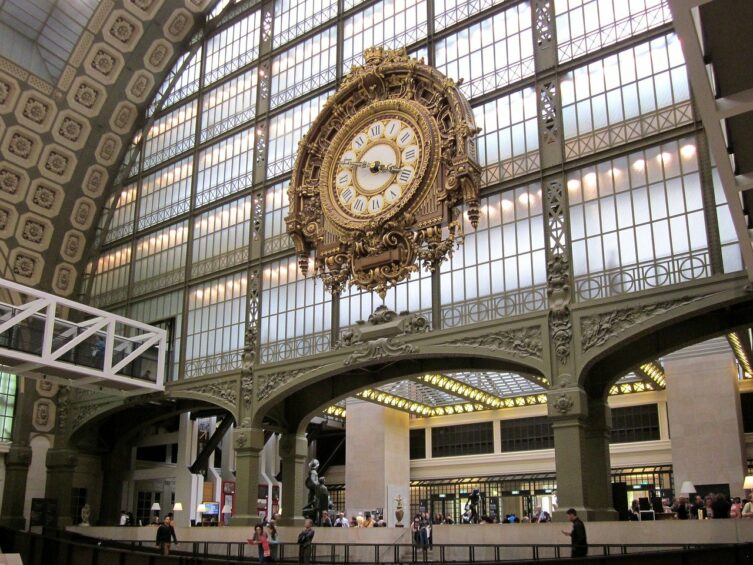
Today a museum, once a train station. This is how the history of d'Orsay can be described in a few words. Built for the world exhibition in 1900, the railway station building served its original function only for 39 years. The electrification of the railways made the trains much longer and did not fit into the station building. A new station was built and d'Orsay was decommissioned. After that, the fate of the building was different, and even its demolition was considered quite seriously. The opponents of this plan, in their own ways, entered the former station on the list of monuments and thus closed the topic of possible demolition once and for all.
Since 1986, d'Orsay has been a museum and exhibits, among others, the greatest works of the Impressionists and Post-Impressionists. The collection of works is really impressive and the building creates a fantastic setting for them. Absolutely brilliant place.
Every year the gallery is visited by about 4 million (!!!) visitors. Admission tickets are fortunately available online.
Check it out: entry tickets to the Musée d'Orsay - [click]
Museum d'Orsay, GPS coordinates:
48°51’37.6″N 2°19’31.9″E
48.860438, 2.325529 - click and route
Musée d'Orsay, nearest metro station:
Solférino - line no.12
27. La Defense
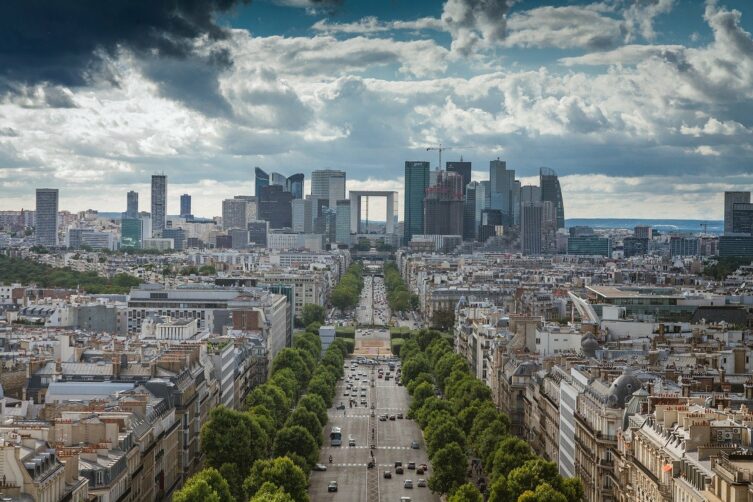
The modern district of glass skyscrapers and bold aluminum constructions made an impressive impression ... 40 years ago. Today it does not make such an impression. Time has meant that such structures have already been created in many cities around the world and for many of us they have become almost everyday life.
It does not change the fact that La Defense remains the headquarters of the largest French companies and the main representative of global companies in France. In terms of office space, La Defense remains the largest business center in Europe.
La Defense, GPS coordinates:
48°53’32.2″N 2°14’12.8″E
48.892272, 2.236891 - click and route
La Defense, nearest metro station:
La Défense train station - line 1
28. Pere-Lachaise Cemetery
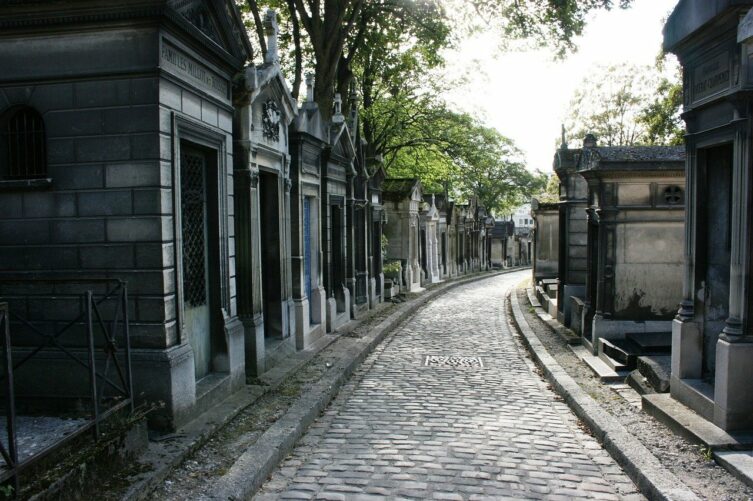
The largest and most famous of the Parisian cemeteries. It was created in the gardens of the villa, which Louis XIV had given his confessor, Father Lachaise (father = pere). Hence, as it is easy to guess, the name of the Pere Lachaise cemetery.
The following are buried in the cemetery:
- Fryderyk Chopin
- Maria Walewska (in the cemetery there is the countess's heart) - lover of Emperor Napoleon Bonaparte
- Józef Wysocki - general of the Polish Army, participant in Polish national uprisings and the Hungarian uprising of 1848-1849
- Honorius Balzac
- Maria Callas
- Amedeo Modigliani
- Molière
- Jim Morrison
- Edith Piaf
- Marcel Proust
- Oscar Wilde
Pere-Lachaise Cemetery, GPS coordinates:
48°51’35.9″N 2°23’20.8″E
48.859957, 2.389105 - click and route
Pere-Lachaise Cemetery, nearest metro station:
La Défense train station - lines 2, 3
29. Catacombs in Paris
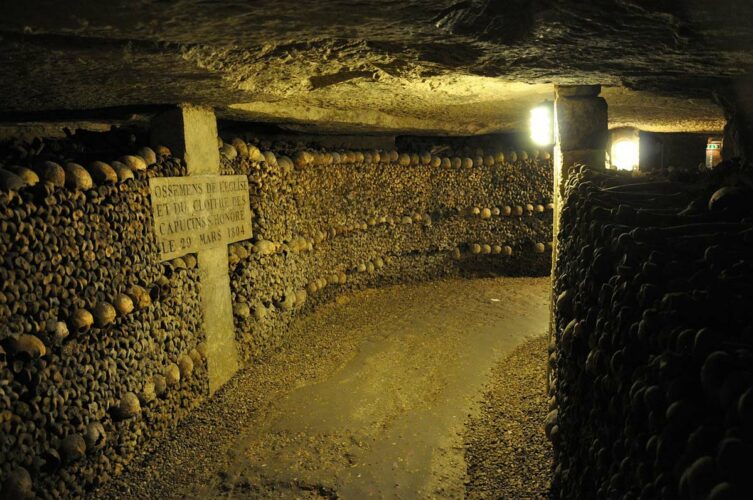
The Paris catacombs are a unique place in the world. The remains of over 6 million people rest in them, and the underground corridors have a total length of about 300 km.
The catacombs are not just an empire of death. Life is intense in the catacombs. Hidden from the eyes of the outside world, officially illegal, but attracting a lot of fans.
You can read more about the official and this hidden and guarded part of the catacombs in a separate entry: Catacombs in Paris - tickets, sightseeing and not entirely legal film of exploration - [click]
check out: tickets to the catacombs from Paris via the Internet – [click]
Entrance to the catacombs in Paris, GPS coordinates:
48°50’01.9″N 2°19’56.5″E
48.833853, 2.332350 – click and route
Visiting the Paris Saint-Germain Stadium (Parc des Princes)
The stadium of the most famous French football club evokes a lot of emotions and attracts crowds of people even outside the dates when matches are played. There are many people willing to visit the stadium, the more so that not everyone has the chance and the money to buy a ticket for a regular match.
Stadium Parc des Princes it has recently undergone an extensive refurbishment and now looks really beautiful. Of course, entering outside the dates of official matches is much easier and cheaper. Almost everyone can afford it, as long as the stadium is open to the public. There are periods when it is completely closed.
Anyway, for all those who want to feel the atmosphere of the stadium of one of the most famous football teams in the world, here is a link to the website where you can check the availability of tickets.
check out: tickets for visiting the Paris Saint-Germain stadium (Parc des Princes) – [click]
Access to the PSG stadium
It's best to take the subway and walk a bit.
Closest stations to the stadium:
– Michel-Ange Molitor – lines 9, 10
– Exelmans – line 9
– Porte de Saint-Cloud – lines 9
Paris Saint-Germain Stadium (Parc des Princes) - main entrance, GPS coordinates:
48°50’31.7″N 2°15’05.8″E
48.842126, 2.251604 - click and route
Attractions outside Paris - the fourth day and the following days
When visiting Paris, it is worth planning an extra day or two to visit the attractions located in its vicinity. It is hard not to take the opportunity to see e.g. Versailles, located 20 km from the city.
In the case of a family trip, an indispensable point of the program will be visiting at least one of the nearby amusement parks: Euro Disneyland or Park Asterix.
Wersal
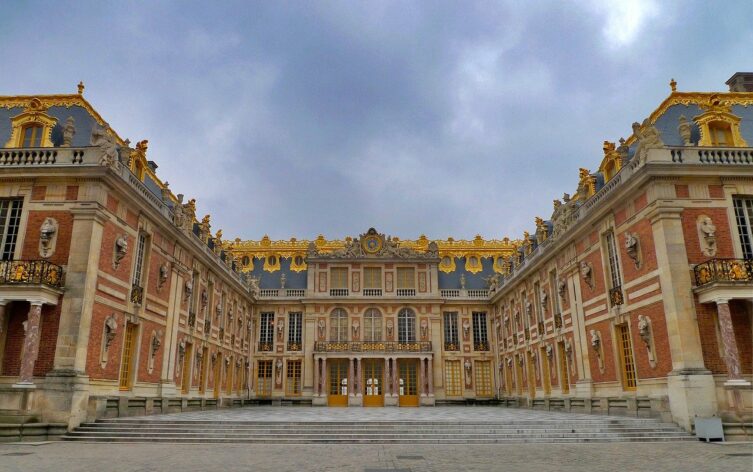
The impressive and shocking seat of the kings of France was created quite unexpectedly as a side effect of the royal hobby: hunting.
The vast and slightly wet forest area on which Versailles is located abounded in forest animals. When Henry IV began to explore these areas in terms of hunting, there were of course almost no buildings here. During the joint hunting, the heir to the throne, Louis XIII, liked the area so much that he bought first part, and then the whole forest estate. The area quickly became a favorite for royal hunting, but it had a drawback: it did not have a comfortable place to stay. The spoiled courtiers complained about the inconsistent living conditions. So the king decided to build a small palace, which was to serve as a comfortable hunting lodge.
The next king, Louis XIV, spent so much time in the palace that he decided to make it even more comfortable. He carried out an extension, then another, and finally came to the conclusion that he would build a real palace, worthy of a king. Ultimately, he moved the entire royal court, ministers and state administration here. Versailles took over the role of the capital of France.
Versailles - how to get there?
Getting to Versailles is very easy. The yellow tourist line goes from the center of Paris to Versailles RER C (runs every half hour).
The RER C line connects with several metro lines in Paris.
- Austerlitz stop - connection with metro lines no .: 5, 10
- Saint-Michel Notre-Dame stop - connection to metro line No: 4
- Invalides stop - connection with metro lines no .: 8, 13
In addition, you can take the RER C line in the city center at the following stops:
- in front of the d'Orsay museum - stop: Musee d'Orsay
- near the Eiffel Tower and Champ de Mars - stop: Champ de Mars Eiffel Tower
The only difficulty may be the fact that the RER C line has a fork and when getting on the train, you need to pay attention to the direction and destination station. I am interested in a train that goes towards Versailles - Rive Gauche.
If you've already managed to get on, you have to drive to the end and get off at the last stop: Versailles Chateau Rive Gauche.
The train station is about 300 meters from the palace so just go where everyone is going. It is impossible to miss.
Tickets for the RER C can be purchased from vending machines in metro and train stations. You cannot go to Versailles on a regular metro ticket, as Versailles is located in the so-called the fourth zone, which is outside the area covered by the standard metro ticket. A ticket for the RER C entitles you to travel by metro.
Versailles - admission tickets
It happened to me once that I got to a place near Versailles and ... the queues to the ticket offices were so (for 3-4 hours) that I gave up the entry. Even if I bought a ticket, after three hours of queuing in full sun, I would not have the strength or desire to visit. I will never commit such stupidity again, and I advise you too. About 5 million tourists visit Versailles each year, and another 4 million visit the gardens. Buying tickets in advance via the Internet is the best upgrade that has been introduced in Versailles for at least 200 years 🙂
Check it out: entrance tickets to Versailles - [click]
Palace of Versailles, GPS coordinates:
48°48’13.7″N 2°07’21.7″E
48.803791, 2.122684 - click and route
Euro Disneyland
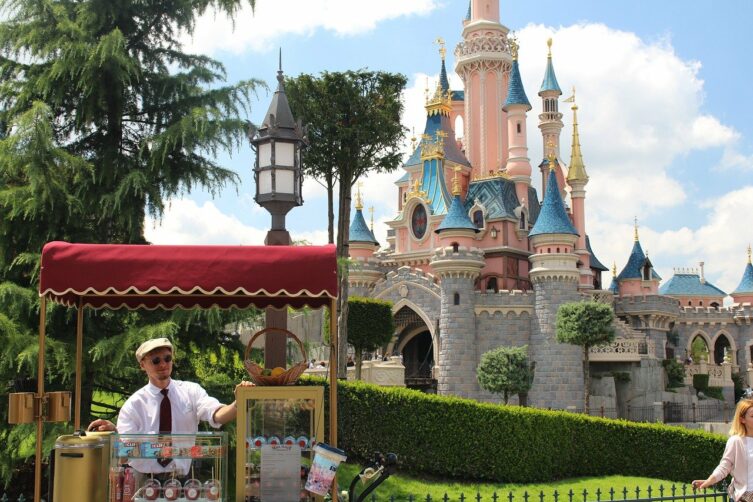
Euro Disneyland is an iconic amusement park for children, located just over 30 km from Paris. He needs to be introduced to anyone in a special way. So I will skip the description of attractions in the park and focus only on organizational issues.
Disneyland Paris - how to get?
A special railway line runs from Paris to the park itself, marked as RER A (it is red in the connection plans). The access is therefore easy and convenient, especially since RER A in the center of Paris is connected to several metro lines:
- Charles de Gaulle Etoile stop - connection with matra lines: 1, 2, 6
- Auber stop - connection with matra lines: 3, 7, 8, 9
- Chatelet Les Halles stop - connection to matra lines: 1, 4, 7, 11, 14
- Gare de Lyon stop - connection with matra lines: 1, 14
- Nation stop - connection with matra lines: 1, 2, 6, 9
The RER A line has a fork, so take the Marne-la-Vallee Chessy train.
Disneyland Park is at the last stop, which is named exactly after the direction of travel: Marne-la-Vallee Chessy.
Further on, it is enough to follow the same direction as everyone else, especially since the train stop is right at the entrance to the Park 🙂
If you are going to Disneyland by car, below are the GPS coordinates of the entrance to the car park:
48°52’34.4″N 2°47’47.5″E
48.876211, 2.796540 - click and route
Disneyland Paris - admission tickets
Disneyland Paris is actually two amusement parks: Disneyland and Walt Disney Studios. One or both of them can be visited. The appropriate option is selected when purchasing a ticket.
Additionally, the ticket may be valid for one or more days. This option is also selected in the appropriate purchase form.
The links below support universal ticket purchase forms for all of the options listed.
Due to the huge popularity of the park, it is definitely best to buy tickets online, of course well in advance.
Check it out:
- 1 day admission ticket to Disneyland Paris- [click]
- multi-day ticket (2-4 days) to Disneyland Paris- [click]
Asterix Park
The second amusement park located near Paris is Park Asterix. The choice between whether to go to Asterix Park or Disneyland is a matter of personal preferences only and I will not advise you here. I will focus on some useful tips related to the organization of the trip itself.
Asterix Park - how to get there?
The best way to get to the park is by car. There are about 40 km to go from Paris, so the trip is neither long nor tiring.
Asterix Park - car park, GPS coordinates:
49°08’14.6″N 2°34’20.9″E
49.137389, 2.572471 - click and route
Access by public transport is not as easy as to Disneyland, but it is possible. One change will be necessary.
First, take the RER B line (blue) towards Charles de Gaulle airport. We get off at the station "Aeroport Charles De Gaulle Terminal 1" and go to the cash desk labeled "Parcs de Loisirs". At the window, we buy a ticket for a bus ticket to the Asterix Park. The bus departs from Platform 3 and runs every 30 minutes from 9:00 am until 1:00 am.
The RER B in central Paris connects to several metro lines:
- Gare du Nord stop - connection with matra lines: 2, 4, 5
- Chatelet Les Halles stop - connection to matra lines: 1, 4, 7, 11, 14
- Saint-Michel Notre-Dame stop - connection to the matra line: 10
- Denfert-Rochereau stop - connection with matra lines: 4, 6
Asterix Park - admission tickets
Entrance tickets to the Park of Asterix are available online and are sold for a specific day as day tickets.
Check it out: admission ticket for 1 day to Asterix Park - [click]
Paris in one day - sightseeing plan
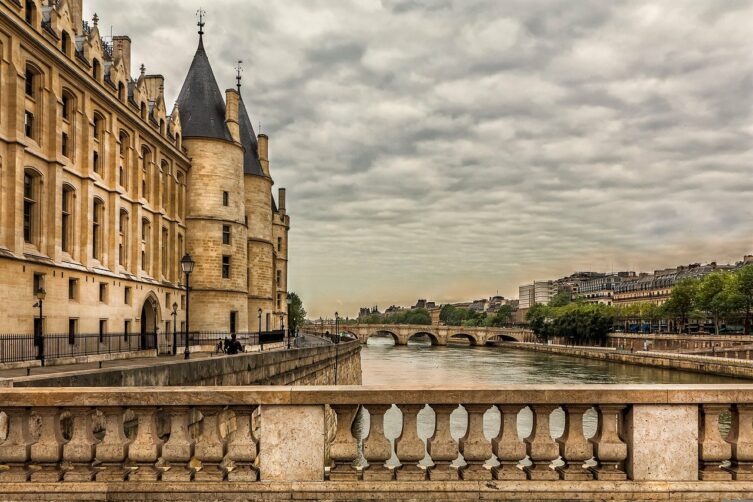
The task seems impossible and in practice it is obvious that it is impossible to visit Paris in one day. But what if you only have that long?
I decided to face this challenge and developed a route that would allow me to see as much as possible in one day. First, look at the map:
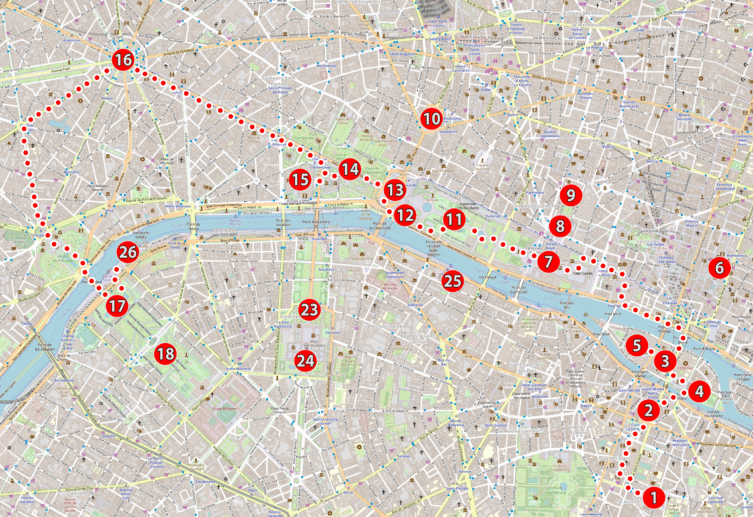
map base: openstreetmap.org
The course of the route - The greatest attractions of Paris in one day:
Pantheon (1) - Latin Quarter (2) - Cite Island (3) - Notre Dame (4) - Sainte-Chapelle (5) - Louvre (7) - Jardin des Tuileries (11) - Concorde Square (13) - Champs-Elysees (14) - Grand Palais (15) - Triumphal arch (16) - Eiffel Tower (17) - Seine (26)
Of course, the numbers at the attractions correspond to the numbering on the maps and in the table of contents and at the headings. I also left the numbers and locations of attractions on the map that are not planned for one day, because it will make it easier for you to modify the route and quickly change your plans. A glance at the map is enough to decide if a change makes sense.
The assumption of the presented plan is such that, due to time savings, we practically give up going inside museums. You can assume that we only enter one museum, or the Eifel Tower instead. I know the choice is difficult, but this tour calls for a compromise. I don't know if it would be possible to complete the entire route, the Louvre and the Eiffel Tower in one day. I rather doubt it, although there will probably be some who can do it.
We view other attractions from the outside and give ourselves a bit of time to feast our eyes on them and take some souvenir photos.
Feel free to analyze the route and encourage you to modify it yourself. Descriptions of all attractions on the route can of course be found in this text.
Paris - accommodation and hotels
Paris is a huge city and Paris is a tourist city. You will find a lot of interesting accommodation here, although it is not always cheap.
From a practical point of view, the key to success is that there is an underground station close to the hotel. The Paris metro works great and if you have a station close at hand, you can get anywhere in the city in no time and without any problems. When analyzing the hotel's offer, check first how close the metro station is. If it is close, you can focus on the remaining parameters of the offer.
At the beginning, I suggest clicking on this link - [click]. The link is prepared in such a way that it filters offers, limiting the results to a reasonable center of Paris only.
There are some useful filters above the search results, such as "Price (lowest first)", after pressing the sort link you will get more useful filters. I often use "Best Rating and Lowest Price."
In addition, below I present a few selected offers that may direct you to interesting accommodation offers.
The People - Paris Nation - [click]
B&B HOTEL Paris Porte des Lilas - [click]
Kyriad Paris 18 - Porte de Clignancourt - Montmartre - [click]
Important to me!
Give the article a good rating (5 stars welcome 😀)!It's free, a for me it is very important! The blog lives on visits and thus has a chance to develop. Please do it and ... thank you in advance!
If you like my guides, you will certainly find the one I created useful guide catalog - [click]. There you will find ready-made ideas for your next trips, descriptions of other tourist destinations and an alphabetical list of guides divided into countries, cities, islands and geographical regions.
I also post link to Facebook profile - [click]. Come in and press "Follow"then you will not miss new, inspiring posts.
Unless you prefer Instagram. I'm not a social media demon, but you can always count on something nice to look at on my instagram profile - [click]. The profile will gladly accept any follower who likes it.
I make the content I create available free of charge with copyright, and the blog survives from advertising and affiliate cooperation. So, automatic ads will be displayed in the content of the articles, and some links are affiliate links. This has no effect on the final price of the service or product, but I may earn a commission for displaying ads or following certain links. I only recommend services and products that I find good and helpful. Since the beginning of the blog's existence, I have not published any sponsored article.
Some of the readers who found the information here very helpful, sometimes ask me how you can support the blog? I do not run fundraisers or support programs (type: patronite, zrzutka or "buy coffee"). The best way is to use links. It costs you nothing, and support for the blog is self-generating.
Pozdrawiam

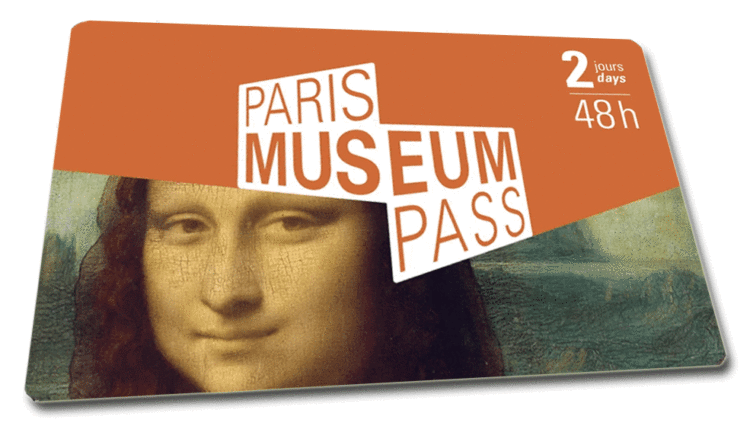



A great guide. I've been to Paris 3 times, not once with such a thoughtful and well-rounded guide. Thanks and respect for the knowledge and work. Grzesiek
Well done. We are going in June. Thank you and best regards.
a great instructor of sightseeing in Paris, all served on a tray.
mega. This is what I needed. Everything clear and legible. I will definitely use it. I'm going in a month and I had a problem with determining what to see, in what order and putting it all together.
A very interesting article. A lot of work 😀 I was inspired 🥰 Thank you very much and best regards.
I don't need to look for anything else. Great post, factual and logical. Guideline for my March trip. Thank you very much!
I'm only going in May, but I've already found something fantastic, that is, this guide. I hope that when I return, I will visit and praise it, because it looks logical, transparent and meets my expectations.
Well written!
I'm impressed! Bravo! This is exactly the information I need to plan my trip 🙂 Thank you very much!
This article will save me a lot of time planning my stay. I'm going next Sunday and I plan to stick to the description. I only need to book a few places. I would like to thank the author for his effort and time.
I used your routes and all your tips to create my own sightseeing plan. All the information was very helpful for which I thank you very much 🙂 I think that thanks to you our week-long stay in Paris was very successful 😀
You pour honey on my heart!
I am very pleased with how this case turned out and thank you!
The most detailed description I've ever read! Great post, straight to the point, no fluff. Attractions well chosen. Respect :) I'm going to read more articles!
I'm going to Paris at the turn of March and April, your post organizes my sightseeing plan very much and saves a lot of time for arranging the route on my own 🙂
great elaboration thanks!
Jack,
I was "with you" in Paris 🙂
Thank you 🙏
I felt something like that
Cool!
Jacek, a fantastically arranged and information-filled plan. I am going to Paris in 3 weeks with my children and I am convinced that everything will work out - thanks to you :) Regards :)
Jacek, a very comprehensive collection of all necessary information. I am going to Paris in May and you have made it very easy for me to plan and visit the city. The instructions are clear, a lot of information on every topic that bothers me. I think everything will go as planned. Thanks again, congratulations.
Deal with the weather and it will be fabulous!
How good that I came here. May weekend in Paris is approaching and only thanks to this information I am starting to understand the topic :). It would be luxurious if I could print it out :), I like to have info in front of my eyes. Thank you very much for these referrals
May in Paris sounds really good!
Nice!
I will be there in April '23, briefly, because 3 days, I read about the places that I will see. I think it is an excellent guide.
Hello. I was in Paris for 2 days (28/02-1/03). All attractions visited with your guide, of course, without some entrances, otherwise it would not have been possible. Thank you very much for the opportunity to use the guide. Regards
wow! Cool!
So Paris squeezed to the max! Way to go!
Jack!
thank you, fantastically laid out plan. A gigantic vector you applied, extraordinary work.
You are also amazing for dedicating your time to others
Hugs, Elizabeth
Thanks a lot and have fun exploring!
Next week I will visit Paris for two days and I will rely on your maps. Well done!
Great guide. I will be in Paris in July and will use your plan. Thank you very much
A well-written guide! In June we will be in Paris with the family and we will gladly use your plan!
I've been fulfilling my dream for 50 years, I've traveled halfway around the world, and somehow I kept putting it off. I'm going at the turn of September and October and thank you very much for such a precise sightseeing plan. I don't know if I can accomplish everything, but with such basics my doubts disappeared.
We didn't manage to look at all these attractions but we only had 24 hours of time. Although you can see a lot in Paris overnight.
I made a short video of what you can do in Paris with just a moment. Maybe it will become a good inspiration for those who are planning or a nice memory for those who have already been to Paris.
Link to the movie: https://youtu.be/zPSTkuCW6M0
Regards!
Incredible !!! Thank you very much ; ))) In August I will be in Paris, it will help me a lot in sightseeing.
I am delighted; this guide saved our spontaneous trip to Paris 🙂 Thank you; everything is wonderfully described!
I don't know if I've written before, but your itinerary is brilliant. It made my trip to Paris so much easier. Everything described perfectly. It's good that you are 😉
I don't know if I've posted this before, but thank you very much! 😀
Great material, very useful!
I'm going to Paris, everything (almost) worked out thanks to your guide.
But I'm lost about tickets. I'm staying overnight in Boulogne-Billancourt, and I can't figure out what ticket zone it is in (it's probably simple). Sometimes I get 5, sometimes 2!
Help 🙂
In my opinion it is south-east of district XVI
We returned from Paris very pleased and fully satisfied. Someone will ask why? Because the above tour itinerary development is perfect. And the Le Consulat restaurant I RECOMMEND. We also ordered snails and firecrackers. Thank you for the very helpful tips.
Pozdrawiam
Another city with a well-prepared plan. While in Madeira, we used your advice and descriptions. In Paris, your tips were once again very helpful. Thank you
The best guide I found on the Internet. This is exactly what I needed to plan my tour individually. I have everything I need here! Bravo 👏
cool thanks